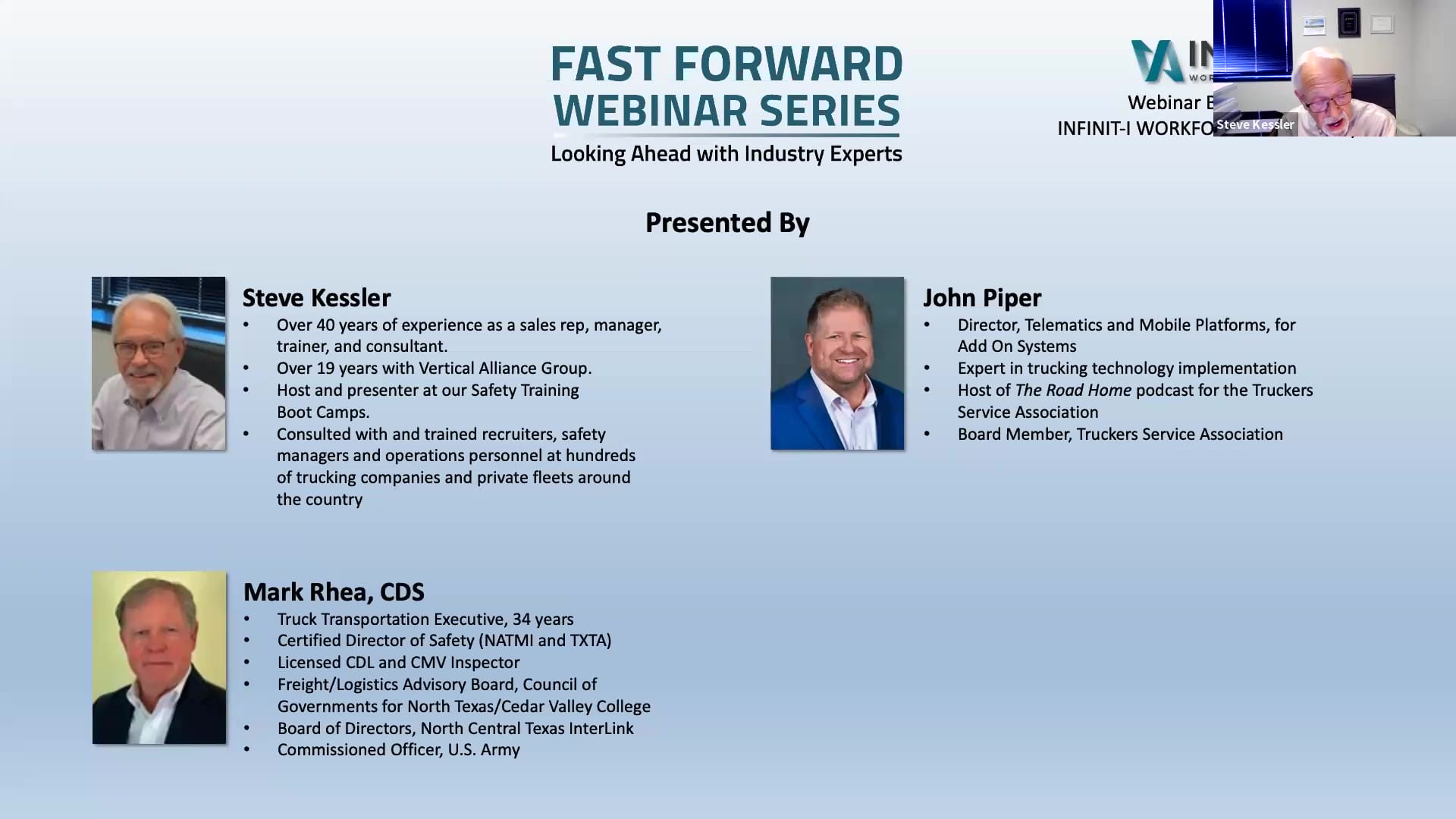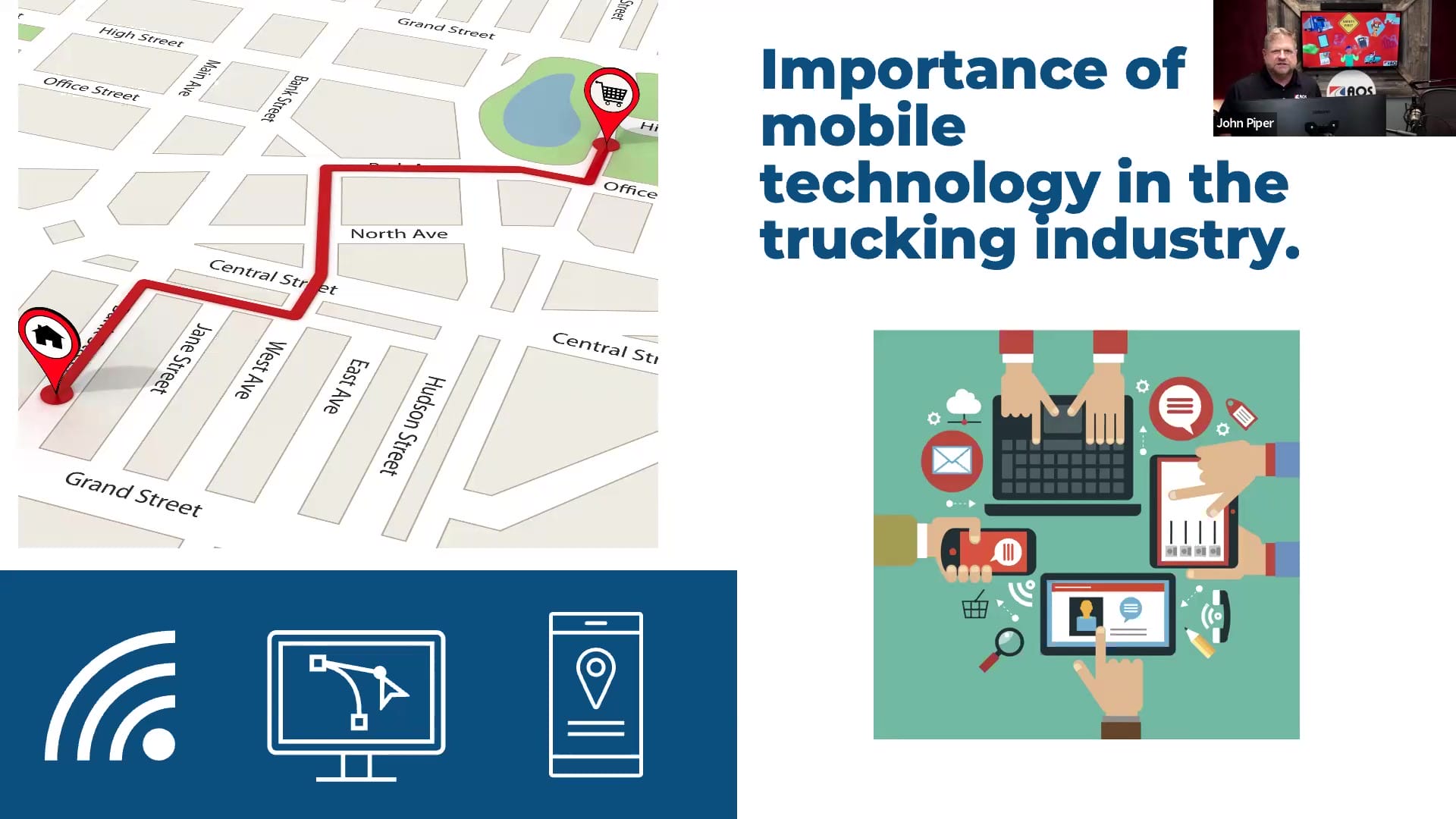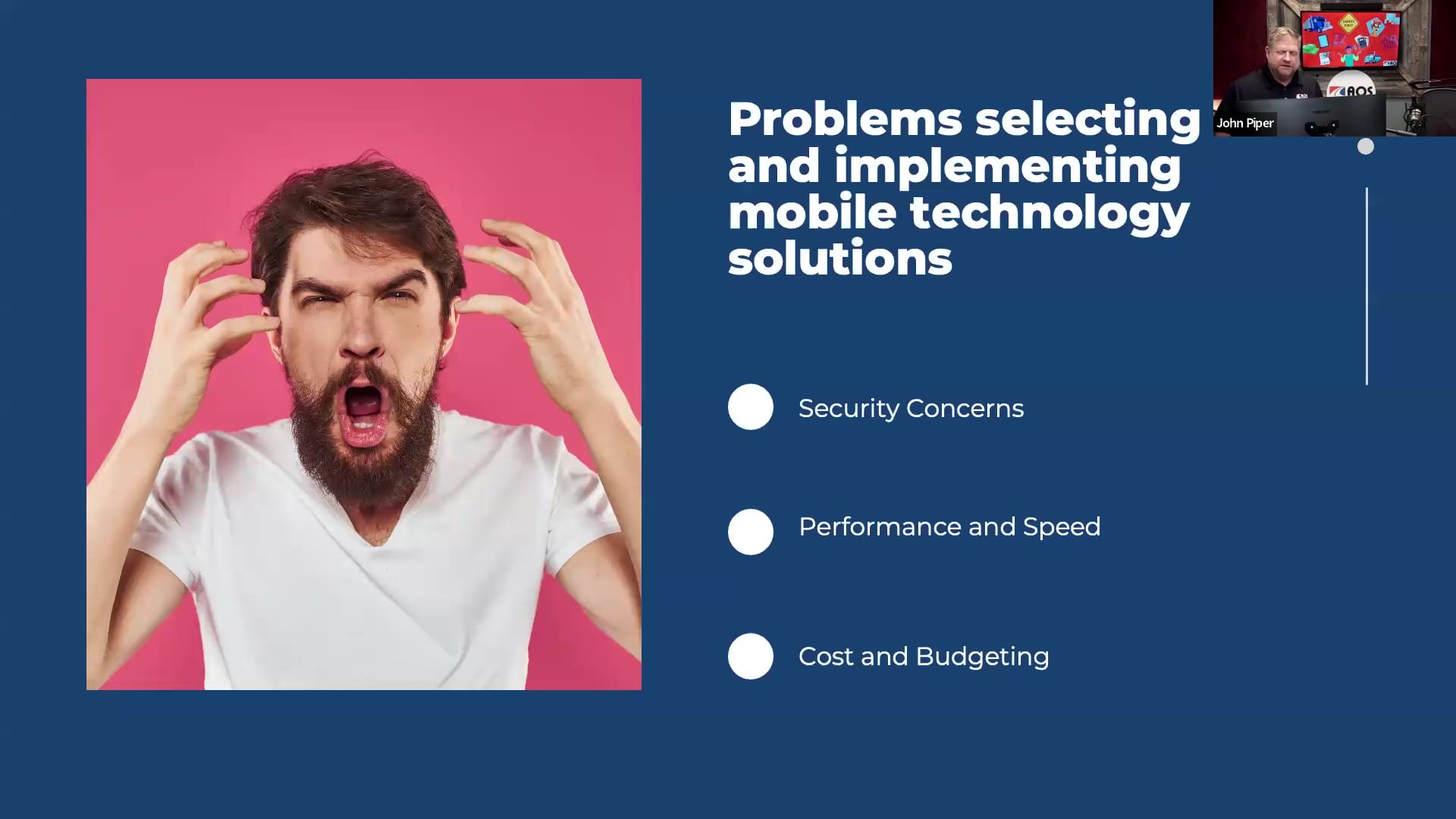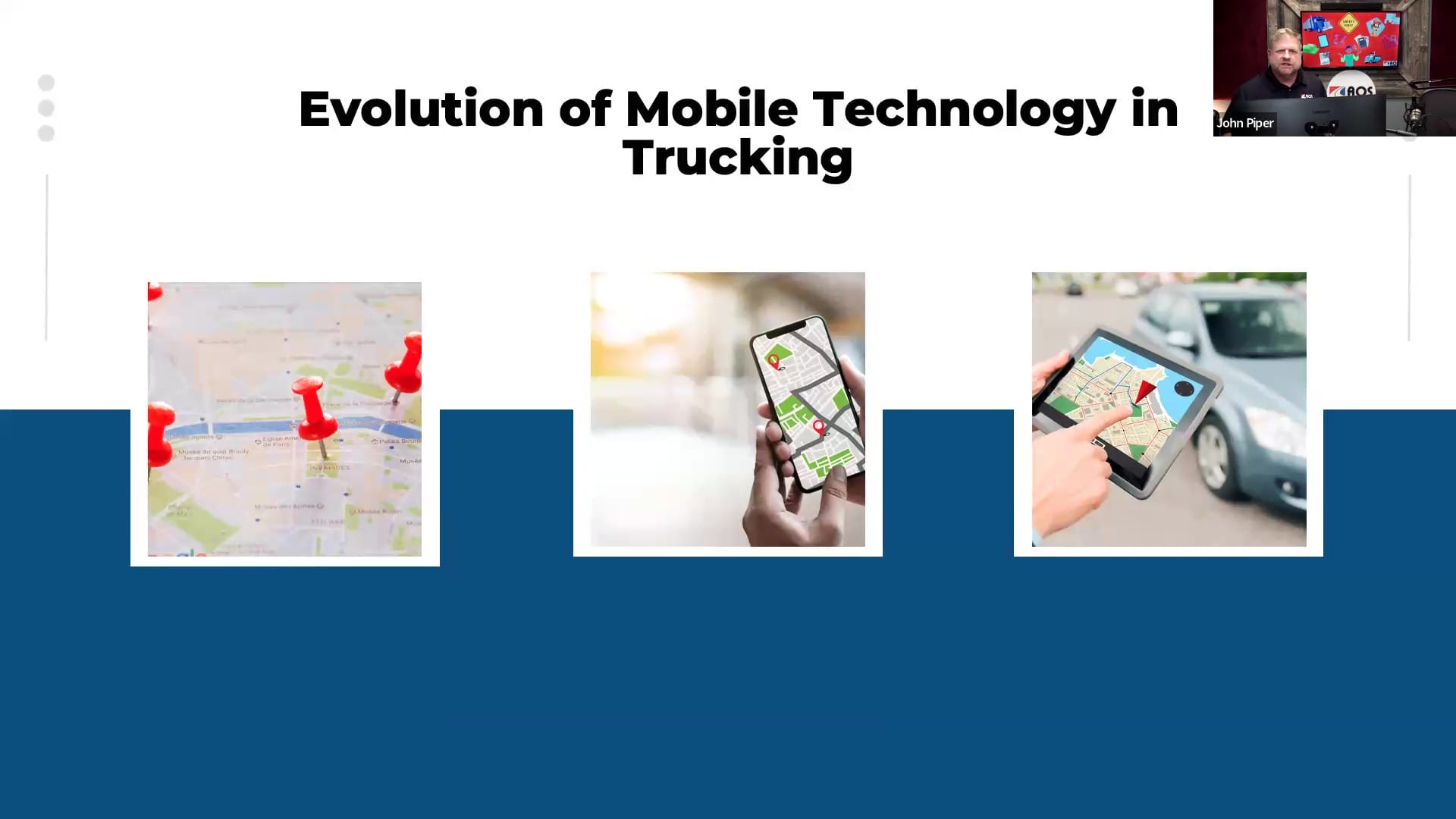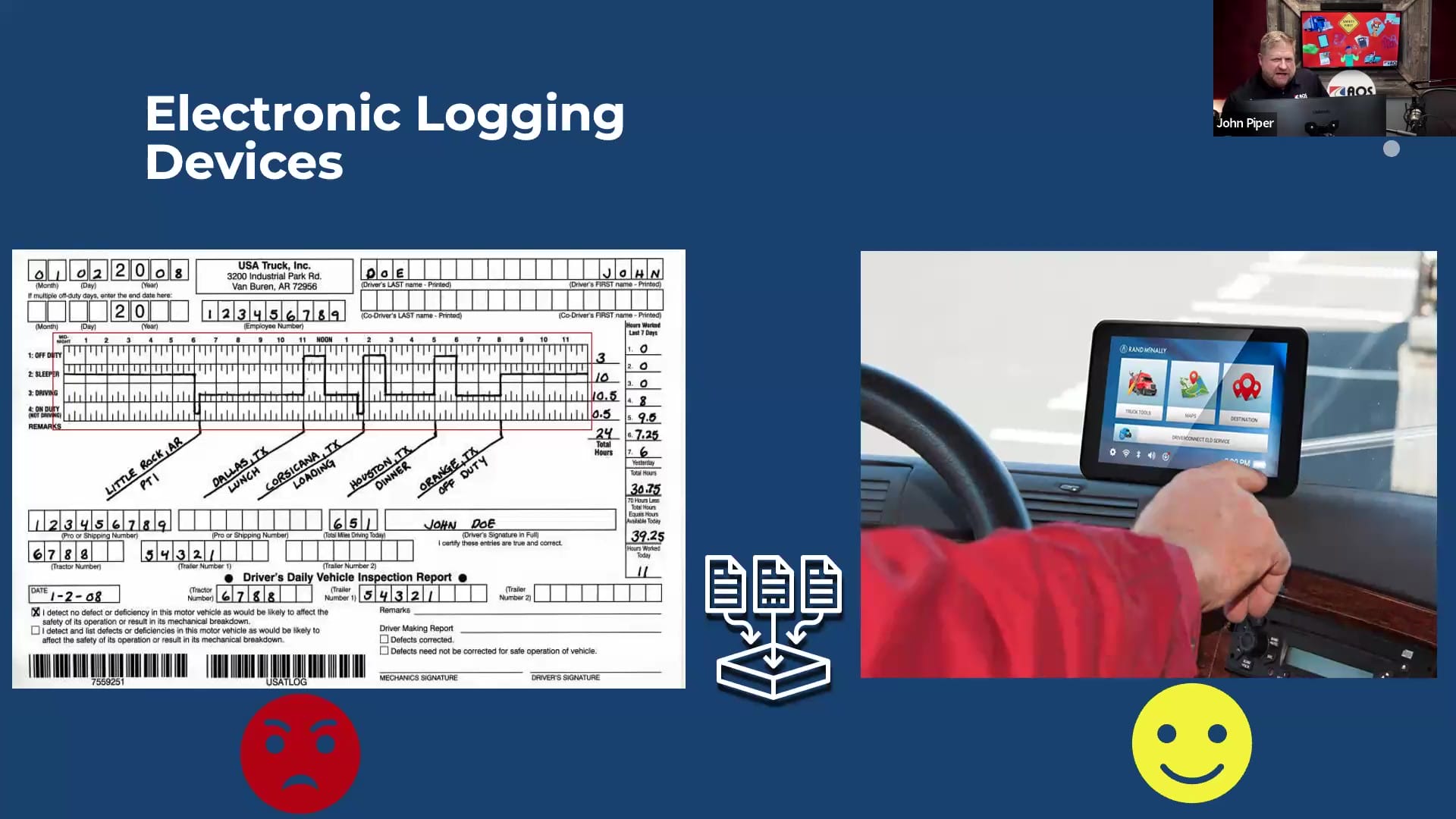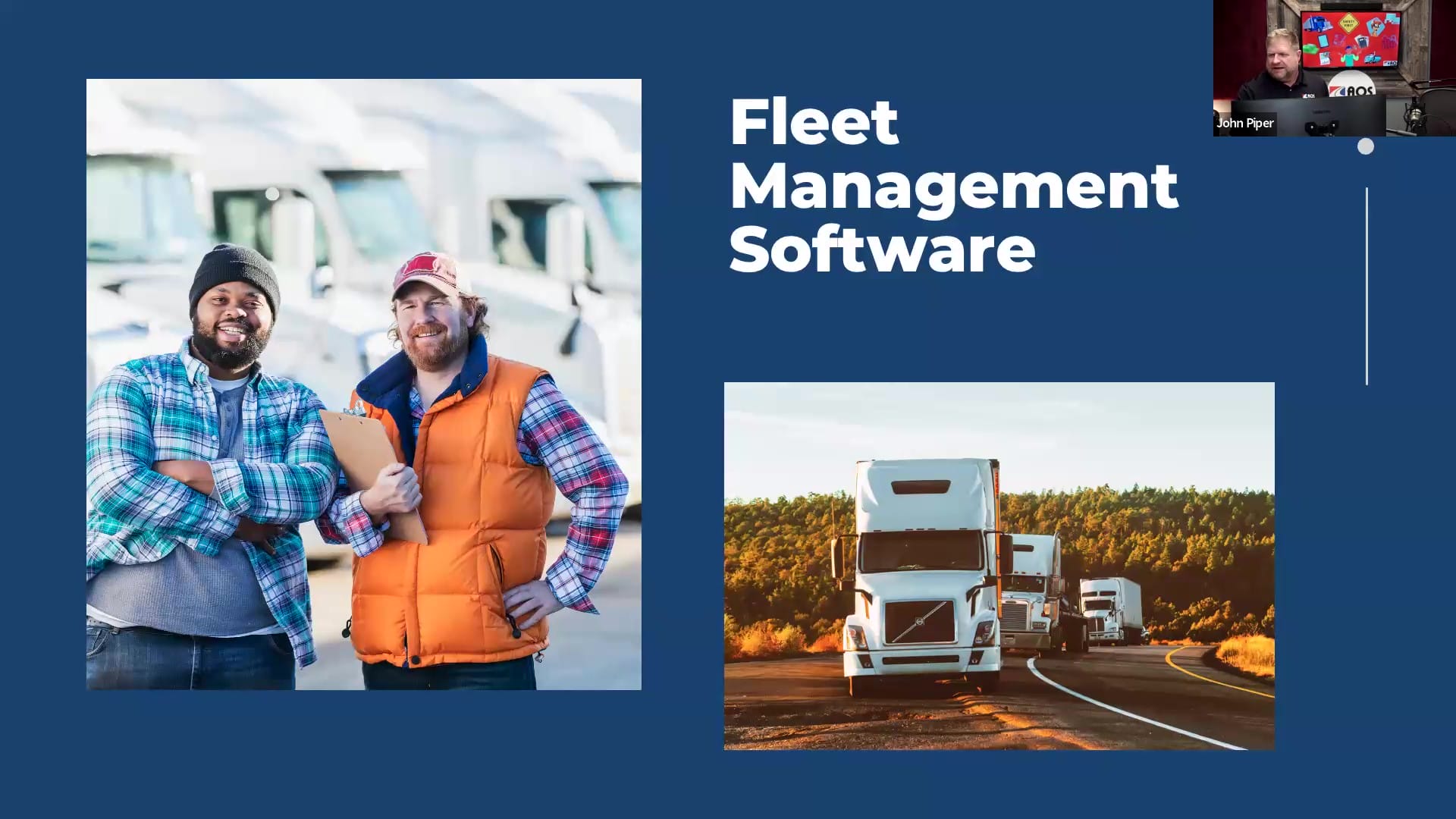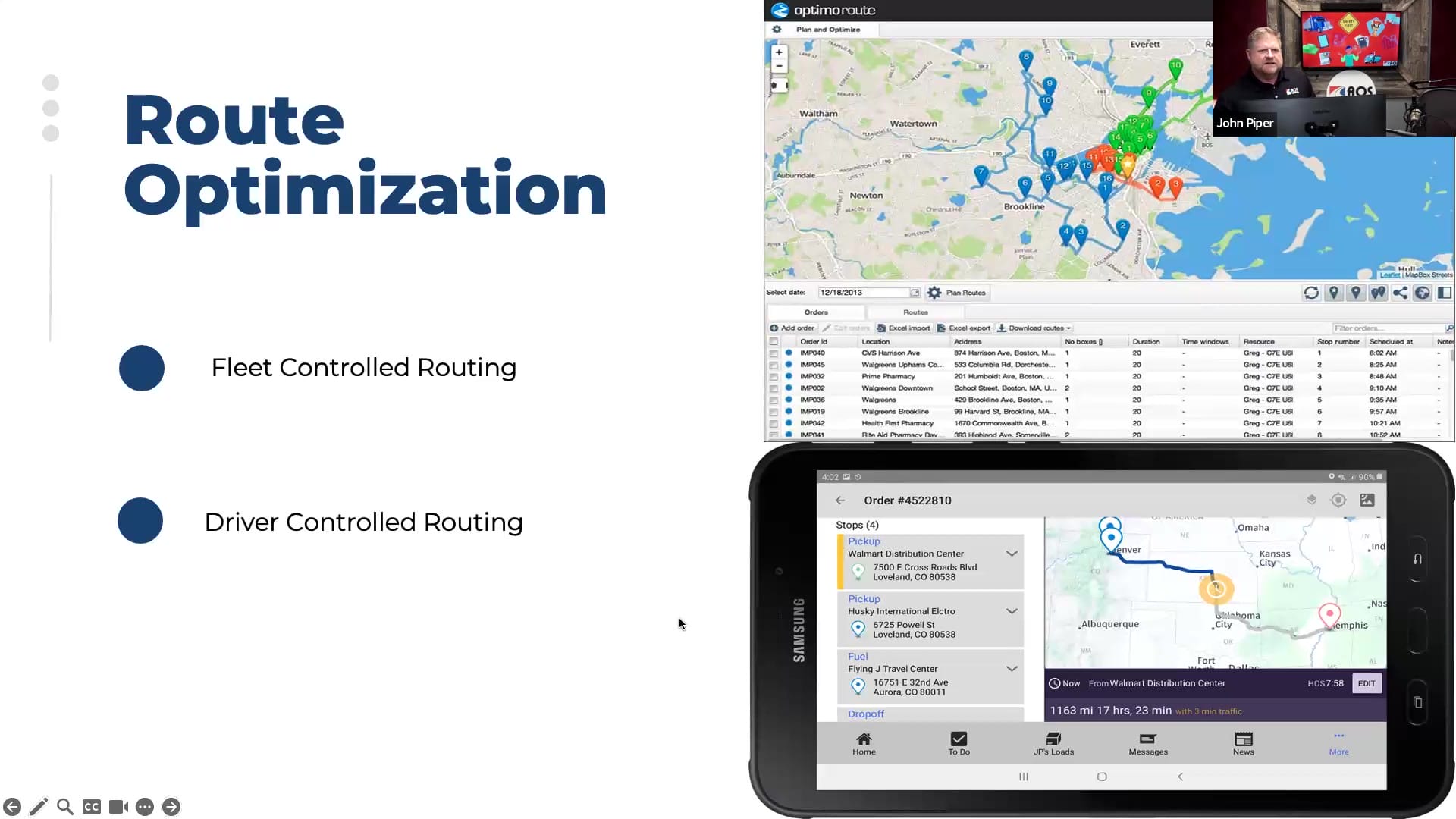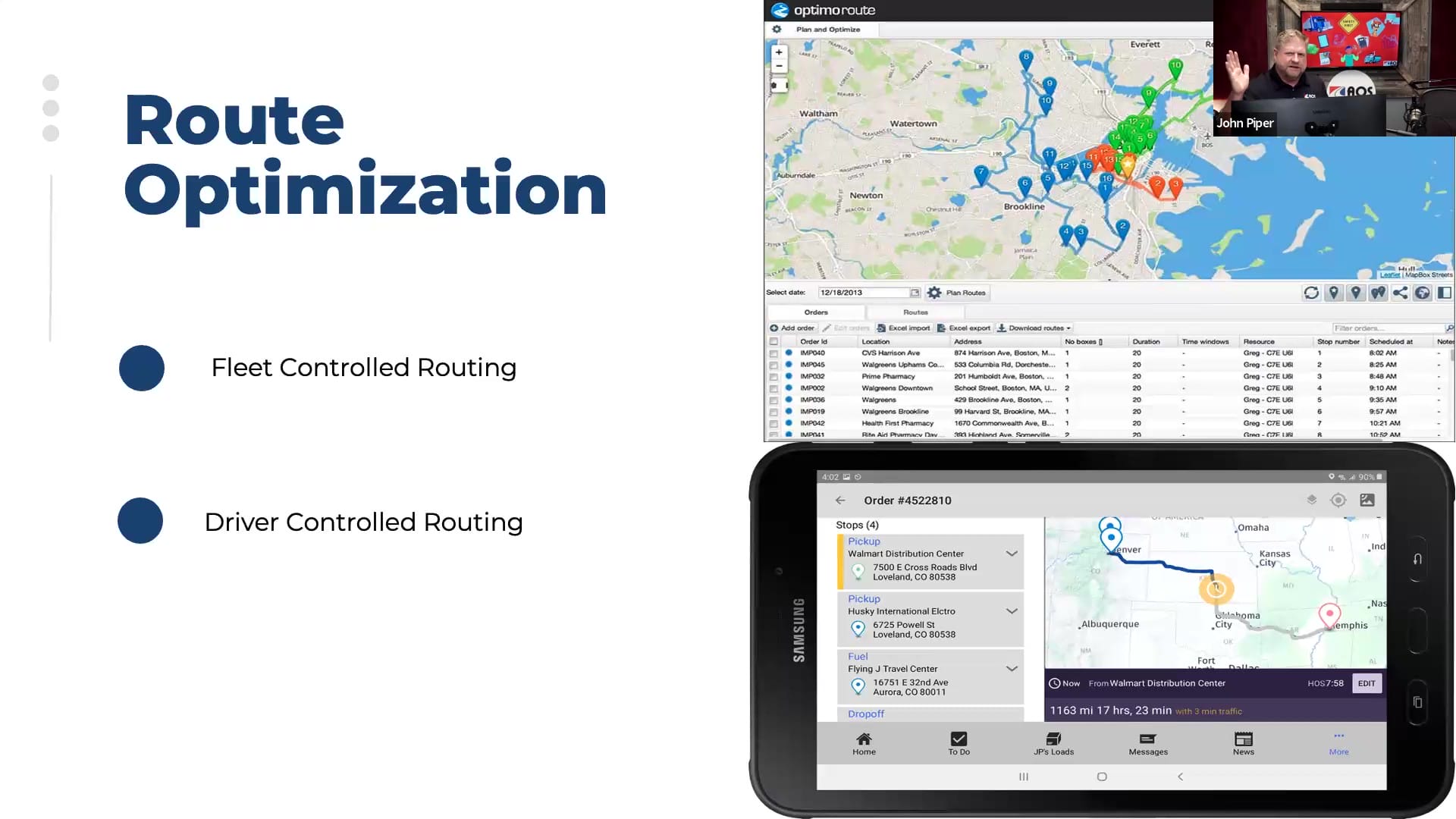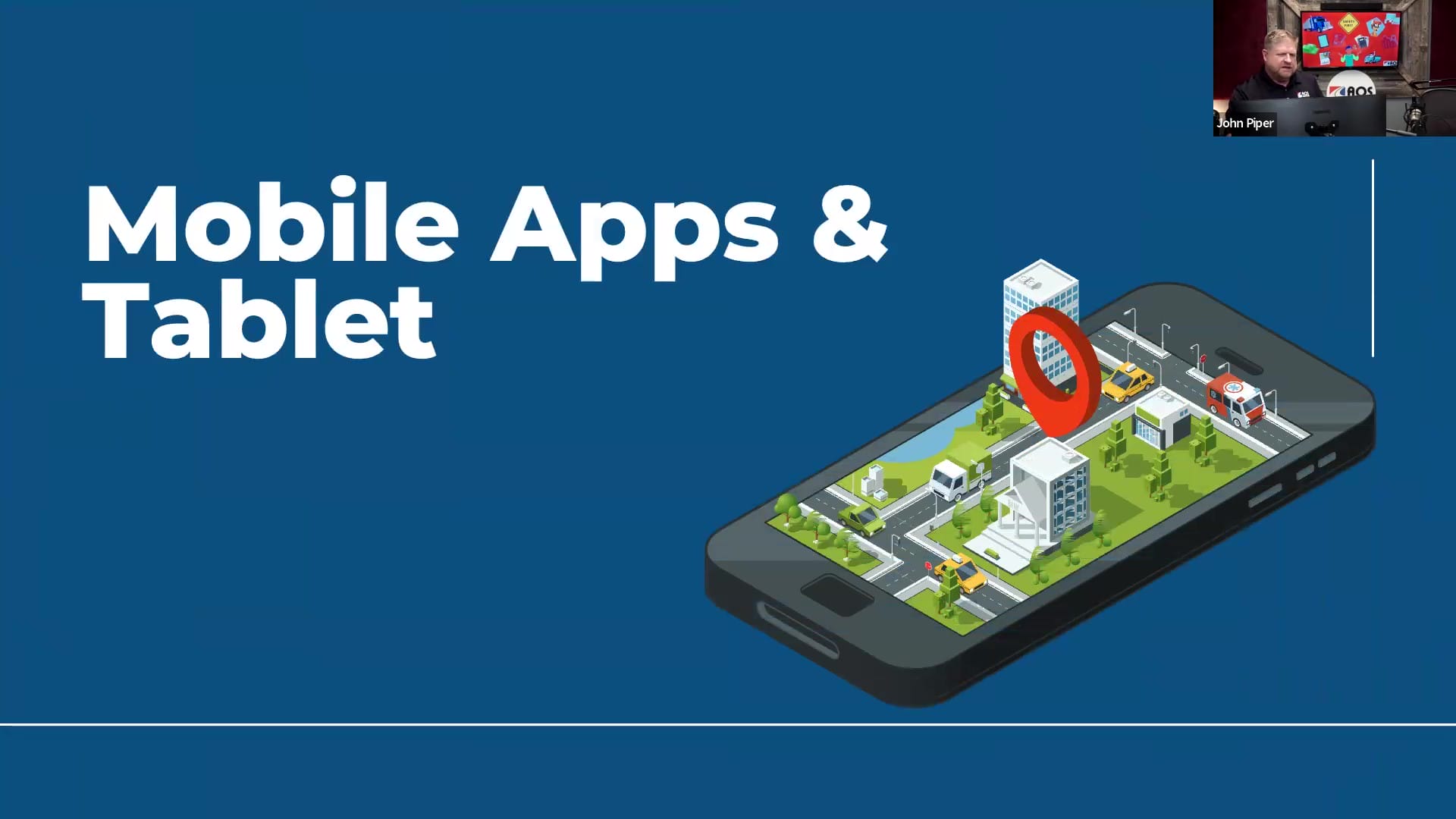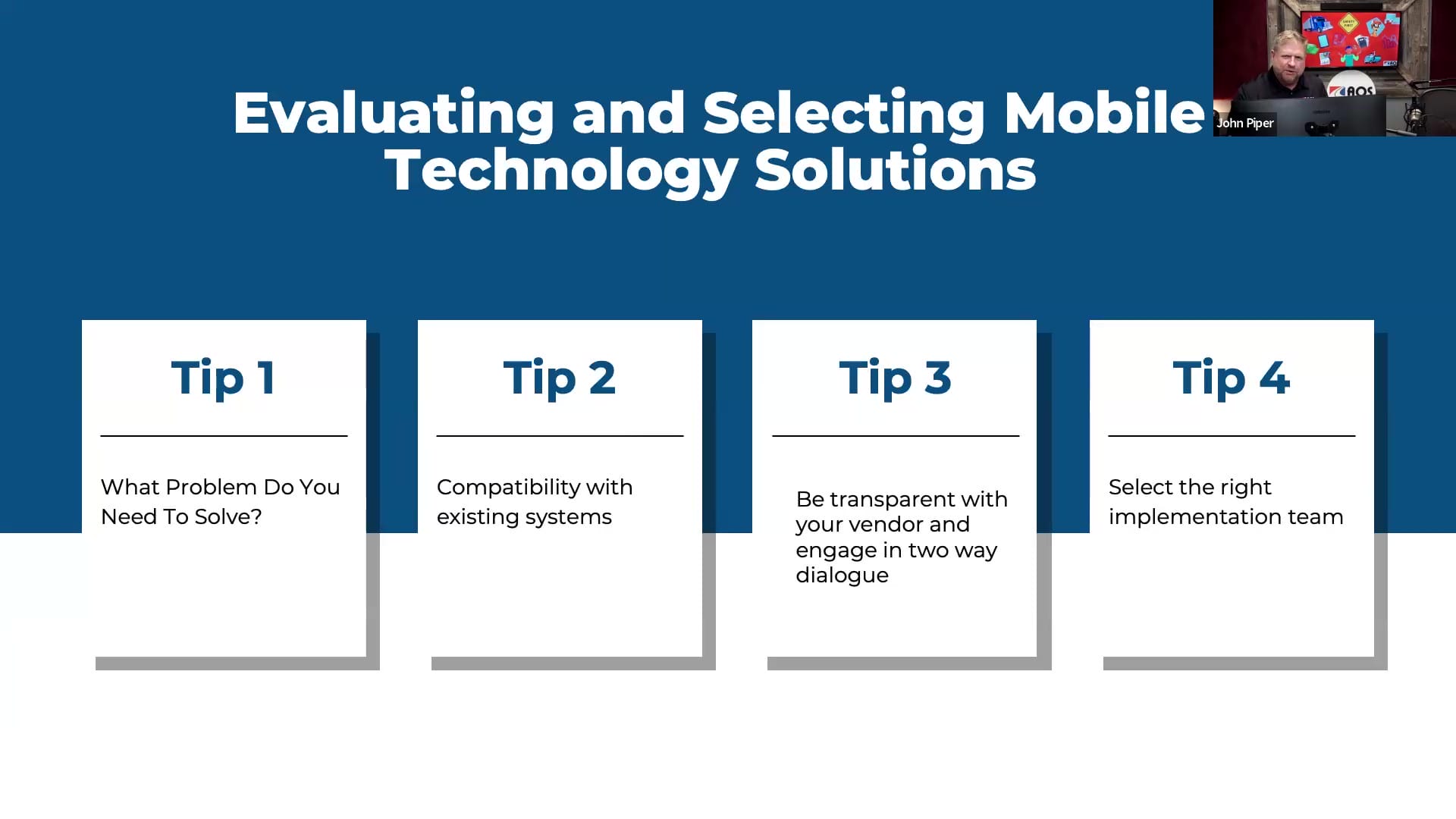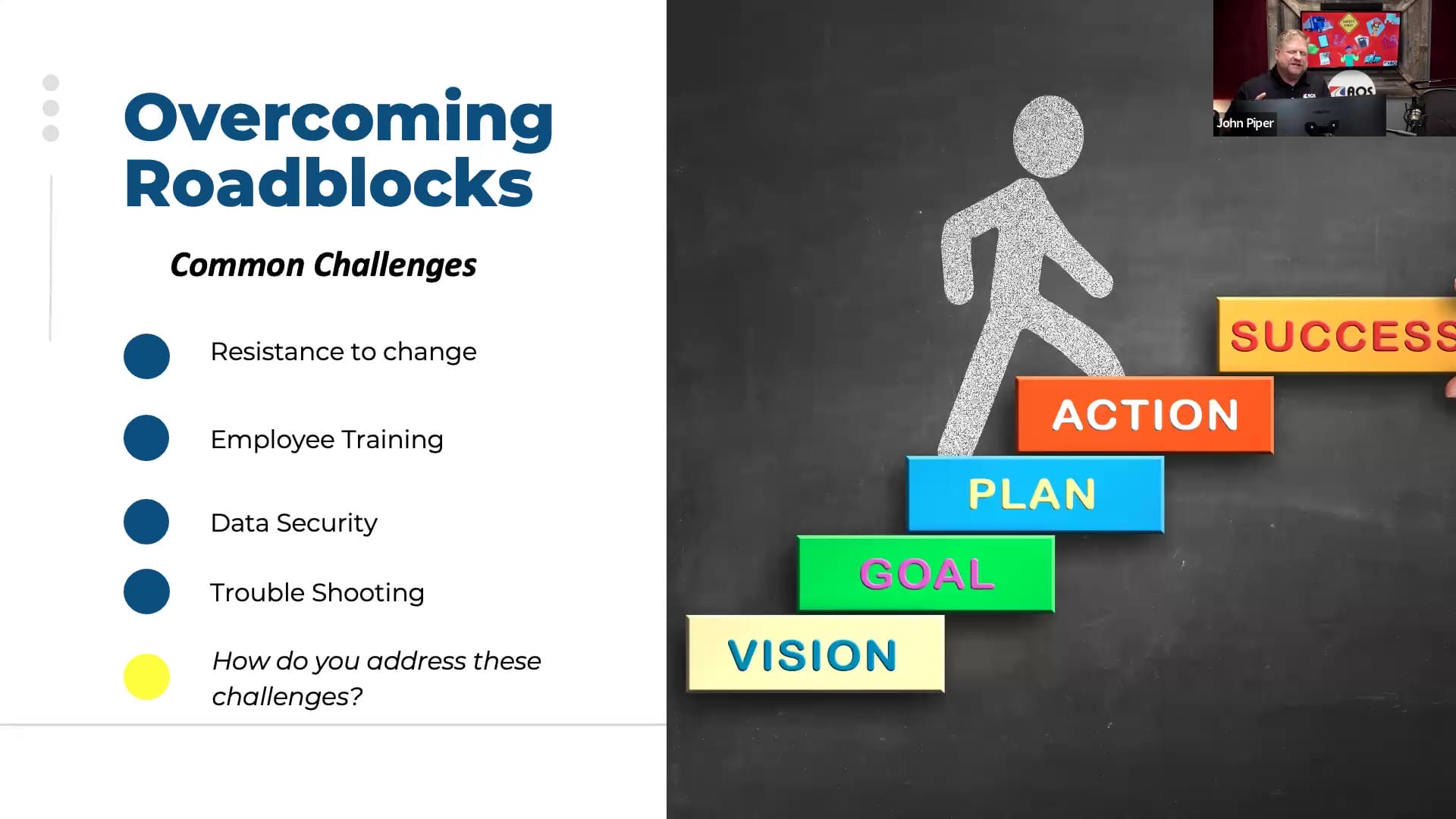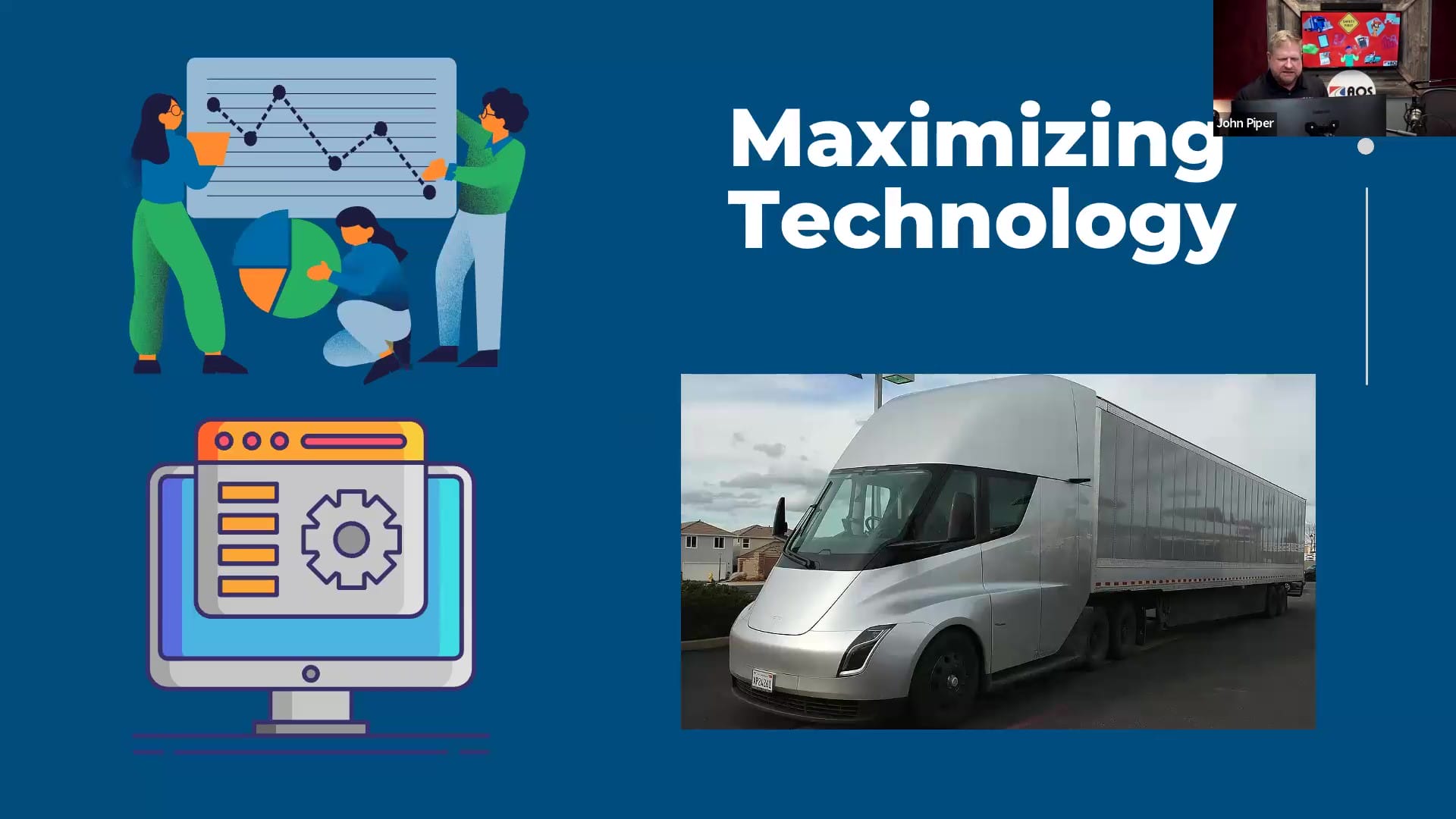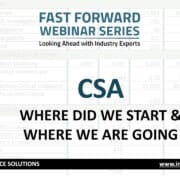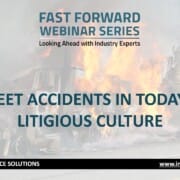Transcription
1
00:00:03.860 –> 00:00:21.499
Steve Kessler: Good morning, everyone welcome to our Infinit-I Workforce Solutions Fast Forward Webinar Series. My name’s Steve Kessler, and I’ll be hosting the program today. So I appreciate you all taking some time out of your day to join us.
2
00:00:21.590 –> 00:00:32.129
Steve Kessler: I think we’ve got a really great topic this morning. the topic today is navigating the road ahead, mastering mobile technology in the trucking industry.
3
00:00:32.210 –> 00:00:47.200
Steve Kessler: So I think that’s a great topic. And tell you what I like for you all to do. Why don’t you jump on the chat and just type in who you are and maybe who you work for and where you’re where you located. So we kind of get a sense where you all are out there.
4
00:00:47.210 –> 00:00:59.439
Steve Kessler: And while you’re doing that I’m going to introduce a couple of folks here. I want you all to welcome Mark Rhea. Marks kind of a regular on our program here, Mark. Say,
5
00:00:59.510 –> 00:01:06.360
Steve Kessler: truck transportation executive. I’ve been in this business for 35 years or more. I’ve known Mark a long time
6
00:01:06.430 –> 00:01:12.250
Steve Kessler: marks a certified director of safety under the Nat. Me. And txt program
7
00:01:12.270 –> 00:01:23.830
Steve Kessler: marks a license CDL and CMV. Inspector, and as also on the freight Logistics Advisory Board for the Council of governments of North Texas
8
00:01:23.910 –> 00:01:35.520
Steve Kessler: and also on the board at the North Central Texas Interlink. So Mark, welcome. What do you think about our topic today?
9
00:01:35.650 –> 00:01:44.010
Mark Rhea: you know, this technology just kind of makes me dizzy these days. It just keeps coming. I’ve been, as as you said, been in this business a long time. And
10
00:01:44.240 –> 00:02:11.419
Mark Rhea: the the technology is coming is coming fast. Some of it work some of it. So maybe a little suspect. But luckily today we’ve got what I would call a pioneer in the world of mobile communication and telematics and transportation technology that I’ve worked with for many, many. He introduced me to electronic logs, as a matter of fact, and and truck tracking. So Mr. John Piper will be very instrumental in in in trying to
11
00:02:11.770 –> 00:02:24.599
Steve Kessler: get us to understand the values. And what’s out there in the marketplace today? Those are kind words, mark good. So everybody let me introduce John John.
12
00:02:24.600 –> 00:02:46.049
Steve Kessler: like, Mark said as a thought leader in the field of transportation technology and and business innovation is very passionate about kind of pushing the boundaries and exploring new possibilities out there. He’s dedicated this career to helping organizations leverage the power of technology to drive their growth and success
13
00:02:46.220 –> 00:02:59.160
Steve Kessler: mark is is currently the host of the road home, which is a podcast dedicated to making a difference in lives of Think about 12,000 truck drivers that he reaches every month
14
00:02:59.410 –> 00:03:08.870
Steve Kessler: John started his career in Operations management with First Fleet, Inc. In the Murphy’s Bar. Excuse me, Murphy’s Borough, Tennessee.
15
00:03:09.000 –> 00:03:26.190
Steve Kessler: and the last 20 plus years with Qualcomm the cloud software sky bit smart drive Dbat sports and has now joined add on systems which is a leading technology software and consulting firm as the VP of marketing there.
16
00:03:26.400 –> 00:03:38.910
Steve Kessler: John’s been instrumental in guiding numerous companies towards digital transformation. He has a deep understanding of emerging technologies and their potential impact on your business.
17
00:03:39.210 –> 00:03:43.970
Steve Kessler: So he’s helped clients across the transportation in this industry harness.
18
00:03:44.010 –> 00:03:53.420
Steve Kessler: You know the power of artificial intelligence, cloud computing data, analytics, telematics, all those things help you to gain a competitive advantage.
19
00:03:53.620 –> 00:04:02.639
Steve Kessler: John’s a native of Kentucky, holds a degree from Western Kentucky University, and an Mba. From Baylor university.
20
00:04:03.050 –> 00:04:07.370
Steve Kessler: You should also know John is a very sought after consultant
21
00:04:07.390 –> 00:04:20.220
Steve Kessler: speaker and advisor. he’s known for his ability to communicate. you know, really complex concepts that and do that in a relatable. And you know, I’d say compelling manner.
22
00:04:20.260 –> 00:04:32.969
Steve Kessler: So through his work with add on systems, he continues to, you know, shape the future of technology and inspire others to embrace it, and sees new opportunities in this digital age.
23
00:04:33.190 –> 00:04:38.149
Steve Kessler: So John, having said all that, I’m gonna turn the program over to you.
24
00:04:38.550 –> 00:05:01.370
John Piper: Welcome, John Steve. Thanks for the warm introduction. Mark Ray. Thank you for those kind words. And you mentioned Dizzy. But I’m sitting there listening to Steve. tell about my background. And I’m like, is that really me? But the bottom line is about man. We’ve been doing this a long time. We’ve seen a lot of change, and it’s an exciting time to be in the transportation
25
00:05:01.680 –> 00:05:08.690
John Piper: technology sector. And that’s what we want to cover our short time together this morning. I’ve seen a lot of
26
00:05:08.820 –> 00:05:14.629
John Piper: evolution and change in our industry like Mark mentioned. I worked with when he was in
27
00:05:14.670 –> 00:05:20.530
John Piper: a Vp. Of operations at a large fleet here in North Texas, introduced
28
00:05:20.640 –> 00:05:24.039
John Piper: electronic communications, GPS
29
00:05:24.530 –> 00:05:29.480
John Piper: communications to drivers it real rudimentary form, text-based messaging.
30
00:05:29.720 –> 00:05:41.920
John Piper: And we’re going to show you the evolution now. And it really is dizzy, dizzying, and confusing to a lot of drivers, fleet operations, safety professionals, and and so many more that are
31
00:05:42.010 –> 00:05:49.550
John Piper: tune into this webinar, and that’ll be watching on the replay. So this gets started. You know, it’s so important
32
00:05:49.710 –> 00:05:53.190
John Piper: to keep drivers connected. Now, you know.
33
00:05:53.490 –> 00:05:55.170
John Piper: customer service
34
00:05:55.330 –> 00:06:10.050
John Piper: safety operations. They want to have their information in real time. Now, customer service, excellence. A lot of a lot of fleets have so much pressure on them to deliver on time every time
35
00:06:10.570 –> 00:06:16.989
John Piper: we’ve been talking about it for years. It’s a thank you list business. They expect your drivers to be on time. But when they’re late
36
00:06:17.630 –> 00:06:34.089
John Piper: they let you know about it. And that’s that can be a problem. So having that communication through mobile technology so important for drivers to get ahead of that and let the shippers and operations know what’s going on with that load. In that particular time
37
00:06:34.430 –> 00:06:37.219
John Piper: training and Development Company culture.
38
00:06:37.290 –> 00:06:44.630
John Piper: so much more can be delivered now through that mobile experience unlike never before. And a lot of drivers
39
00:06:44.870 –> 00:06:47.510
John Piper: we don’t get to see, but every couple of weeks
40
00:06:47.890 –> 00:07:04.679
John Piper: a lot of over the road drivers are out there for 3, 4, 5, 6 weeks, sometimes 3, 4 months at a time versus those Ltl. Or contract dedicated or private fleet drivers. So you have to be thinking in terms of technology that can reach
41
00:07:04.790 –> 00:07:10.270
John Piper: both those drivers that are home each and every night, and those that you don’t see. But maybe 2 or 3 times a year.
42
00:07:15.900 –> 00:07:17.740
John Piper: like we’ve talked
43
00:07:18.080 –> 00:07:27.319
John Piper: mostly operations, safety folks owners. They’re getting bombarded. I personally get bombarded with technology solutions
44
00:07:27.410 –> 00:07:35.059
John Piper: for my business each and every day for Folks that want to do work here at add on systems, consult with Sa software and
45
00:07:35.300 –> 00:08:01.599
John Piper: new technology, make our business better. I know the fleets get bombarded as well. So couple of things to consider here, you know, security we hear about malware hacking. You know, it’s so important to have a secure network. And when you have all this technology out there connecting to drivers. And in the Tractors technology installed on the tractor, on the trailer, on the refur unit.
46
00:08:01.970 –> 00:08:07.680
John Piper: There is big concern that people can get on those networks and maybe adjust
47
00:08:07.730 –> 00:08:24.609
John Piper: you refur temperature or change it unbeknownst to you, maybe change your speed on your tractor, so we don’t hear a lot about that. But it’s becoming more and more prevalent as I go around the country and talk to CIO CTO’s technology
48
00:08:25.010 –> 00:08:30.960
John Piper: network administrators, folks like that are concerned about that. So keep that in mind.
49
00:08:31.040 –> 00:08:36.989
John Piper: some technology solves some of the problems, but not all. You may have a mixed fleet of drivers.
50
00:08:37.020 –> 00:08:44.360
John Piper: and you got to think in terms of hey, what’s going to be the best common denominator? The solution? It is going to help
51
00:08:44.500 –> 00:08:52.669
John Piper: all my drivers, or, more importantly, how you can customize applications to fit. Perhaps you’re over the road fleet.
52
00:08:52.770 –> 00:08:58.680
John Piper: perhaps fit your dedicated contract customer fleet. Perhaps your
53
00:08:58.930 –> 00:09:11.349
John Piper: drive an fleet versus your refrigerated fleet versus your flatbed fleet or your final mile delivery fleet. Those are all things you need to take into consideration when you’re selecting technology.
54
00:09:12.040 –> 00:09:22.649
John Piper: and if any any of us have been sitting down with the CFO typically, they go to the last item on that spreadsheet when you’re looking at Roi cost
55
00:09:23.100 –> 00:09:38.270
John Piper: a lot of times. The person writing the check does not consider all the value and really the customer experience versus just the cost. And and today’s freight market. No secret cost is
56
00:09:38.430 –> 00:09:51.459
John Piper: so much more important today than it was just 18 months ago, 24 months ago. when freight volumes were higher and freight rates were higher, so cost is obviously at the top of everybody’s a awareness.
57
00:09:54.590 –> 00:10:00.670
John Piper: And, Steve, I know you mentioned people in the chat. I’m not going to be watching the chat right now, but at the end we’ll have Q. A. So
58
00:10:00.930 –> 00:10:13.459
John Piper: as I’m going through here, I like to make this conversational, but we will save the questions. So the end, and we’ll try to get to most of those here in just a few minutes on the Q. A
59
00:10:13.890 –> 00:10:27.100
John Piper: I got I mentioned Mark raised a great example. I think it was 1997, 1998. We were working with a fleet he was managing, and it was a very large GPS tracking device
60
00:10:27.750 –> 00:10:56.449
John Piper: in tech space messaging. And that was really it. And everybody thought, Wow, how how great is this? We can keep up with our drivers. You know we know where they are once an hour, or if they send in a message, we can kind of see where they are in terms of are they going to make their delivery on time? But there wasn’t much integration with safety. No electronic logs have hadn’t become prevalent at that time, but it was a tool instead of the drivers having to call in from a pay phone.
61
00:10:56.980 –> 00:11:03.110
John Piper: and the young folks here on the webinar today. You might have to Google images of what a payphone looks like.
62
00:11:03.330 –> 00:11:08.149
John Piper: because there aren’t any pay phones. I I think I saw some in a hotel recently.
63
00:11:08.470 –> 00:11:19.169
John Piper: But we all have cell phones now. So it’s a lot easier to get a hold of a driver. And then, you see a picture of the cell phone there. Once the cell phones and the smartphones became more prevalent.
64
00:11:19.200 –> 00:11:23.170
John Piper: It was easier to get information to the driver. Stay connected
65
00:11:23.710 –> 00:11:38.769
John Piper: made the driver’s life so much better versus having to call for dispatch or stay in that truck. Stay tether to that tractor, and we’ll talk about the issues of parking here in a minute. But can you imagine being a professional driver waiting for dispatch?
66
00:11:38.780 –> 00:11:44.620
John Piper: And the only way you know you’re going to get a dispatch is to go out and check that display
67
00:11:44.860 –> 00:11:47.610
John Piper: that monochrome display in your tractor
68
00:11:47.940 –> 00:11:57.750
John Piper: every couple of hours while you’re maybe trying to get some rest, or you’re in a truck. Stop having dinner getting a shower things have changed. And now we see a lot of tablet
69
00:11:57.810 –> 00:12:06.059
John Piper: tablet base. I’ve got a an ipad here right now. I use a a tablet myself, but android tablets, iphone tablets.
70
00:12:06.110 –> 00:12:09.299
John Piper: It’s just a way to to further connect drivers
71
00:12:09.360 –> 00:12:16.409
John Piper: or remote workers can be maintenance technicians as well to your business, which is so powerful.
72
00:12:19.120 –> 00:12:25.190
Mark Rhea: Yes, John, one of the things we learned is is obviously your customers want to know where that freight is all the time.
73
00:12:25.300 –> 00:12:44.879
Mark Rhea: and and I think one of the things that has emerged is, yes, tracking is important. Where’s where’s my freight. Where is it when it’s gonna but how do you convert that into improvement in crash frequency and things then on the safety side has really really taken off in the last few years. So
74
00:12:44.900 –> 00:12:52.889
Mark Rhea: it, it’s got multiple values to include, where is my freight? Is it on time?
75
00:12:53.160 –> 00:12:54.950
Mark Rhea: But that, also
76
00:12:55.110 –> 00:12:59.360
Mark Rhea: used correctly, can improve crash frequency.
77
00:12:59.570 –> 00:13:06.700
John Piper: Yeah, Mark, that’s a great segue. You know, this is just kind of a a slide to get people to think about what’s the impact
78
00:13:07.390 –> 00:13:24.449
John Piper: with the technology on our business. And I can’t think of a more prolific piece of technology in the last couple of years. I was early I saw this early on, probably 7, 8 years ago, forward, facing cameras and inward facing cameras.
79
00:13:24.750 –> 00:13:30.419
John Piper: And there’s a lot of things actually, we do here at add on systems as well, where we take all this data.
80
00:13:30.650 –> 00:13:50.729
John Piper: because what we found Mark historically is, there’s so much information. And all these silos, these different systems in the Tms system and the the camera provider usually has their own user interface. And all that data sits over in another system. And then there’s a claim system over here. So bringing all that together.
81
00:13:51.140 –> 00:13:56.929
John Piper: using cameras to mitigate risk before it happens. That’s the key.
82
00:13:57.060 –> 00:14:19.399
John Piper: You know, everyone has tools now to how how you handle a accident, a a collision? hopefully. I hate to talk about it, but it’s a necessary part of our business fatalities, you know, and I was at a safety meeting down in Dallas with a lot of law enforcement, talking about the when you’re the first responder on a fatality.
83
00:14:19.430 –> 00:14:24.459
John Piper: How you deal with that. And you know, it’s it’s so tough. So we’re all about
84
00:14:24.840 –> 00:14:28.450
John Piper: 0 fatalities out there. We know it’s a that’s a stretch goal.
85
00:14:28.470 –> 00:14:37.730
John Piper: But with the camera technology mark, you can mitigate risk in advance. You can see certain behavior. You know, John Piper has certain trends
86
00:14:37.770 –> 00:14:39.250
John Piper: driving at
87
00:14:39.780 –> 00:14:53.300
John Piper: 8 30 in the morning versus 8 30 at night, and there’s certain triggers. Now. AI has become a big part of this artificial intelligence and tying into other systems in the truck as well with speed
88
00:14:53.960 –> 00:15:01.069
John Piper: all the data that’s on that tractor, and it gives really safety and risk professionals and operations, people
89
00:15:01.160 –> 00:15:21.130
John Piper: and ownership really a lot of tools to help coach. And I know vertical alliance. So Infinit-I the platform that that you guys provide is all about training and getting ahead of a potential accent. So so great points altogether
90
00:15:24.190 –> 00:15:28.889
John Piper: logging. you know, I remember when I first started operations.
91
00:15:29.150 –> 00:15:36.749
John Piper: We had a dedicated contract carriage business. The drivers will be out for 2 or 3 days at a time, very safe drivers.
92
00:15:37.680 –> 00:15:49.879
John Piper: but they would come back, you know a lot of times at 2 in the morning, 3 in the morning, 8 in the morning. Kind of catch up their logs on paper. You know. I know the safety professionals don’t want me to say that. But that was just a fact
93
00:15:49.900 –> 00:15:56.920
John Piper: that was back in the the mid to late nineties. nowadays. There was a lot of pushback on electronic logging
94
00:15:57.420 –> 00:16:05.740
John Piper: only from drivers, especially independent contractors. That thought, Hey, this is going to impact my knowledge which is going to impact my pay
95
00:16:05.870 –> 00:16:11.230
John Piper: when I first got in trucking. I remember a driver like Week one, said John.
96
00:16:11.260 –> 00:16:20.679
John Piper: and he patted his wallet on the back of his rang or deans. He was a great driver from Somerset, Kentucky said, as long as you don’t mess with the driver’s pay
97
00:16:20.750 –> 00:16:33.059
John Piper: you’ll be all right in this business, and that’s been true, and that’s been true. When drivers feel like they’re not getting paid properly, you will hear about it. Everybody on here knows what I’m talking about. But but now the transition to electronic logs
98
00:16:33.220 –> 00:16:53.159
John Piper: has been so positive because now fleets no, everyone’s on the same playing field drivers like it because it’s less headache. It’s less work. Drivers do not want administrative work. Is that fair to say more? Absolutely the the the elimination of having to do a recap. Mathematics is what was a big plus.
99
00:16:53.490 –> 00:17:01.150
John Piper: Yeah good stuff. And there’s so many technologies out there. Now, you know, eld really brought a lot of
100
00:17:01.540 –> 00:17:14.139
John Piper: new providers to the forefront. And there’s a plethora, you know, we don’t necessarily recommend which ones you want to use. You know, we can help you guide you on that. But there, there’s a lot of great solutions out there.
101
00:17:14.380 –> 00:17:26.039
John Piper: you know, fleet management software. That’s another one. That lot of fleets have used the same platform for for many years. They they tweak it, they modify it. it’s important to have software in your business
102
00:17:26.440 –> 00:17:31.200
John Piper: that can do what you need it to do. And it’s simple and effective.
103
00:17:34.160 –> 00:17:36.530
John Piper: One thing that ties into safety
104
00:17:36.710 –> 00:17:40.459
John Piper: is route optimization. Couple of things here
105
00:17:40.710 –> 00:17:51.189
John Piper: there’s fleet controlled routing where a lot of the larger fleets that I work with will send out a class aid specific route potentially, even with fuel stops
106
00:17:51.720 –> 00:17:55.099
John Piper: like you can see on this display. Down here you can see my mouse moving.
107
00:17:55.470 –> 00:18:08.050
John Piper: This route here has a fuel stop, and that’s usually tied into to a fuel optimization, figuring out, using all this data and analytics to figure out, hey, where’s the best place to fuel based on my route.
108
00:18:08.090 –> 00:18:12.730
John Piper: based on the cost of the fuel, and it drops it right into the route.
109
00:18:12.850 –> 00:18:20.539
John Piper: The flip side of that is driver control routing. There’s a thing called app fatigue, and if, if I showed you my
110
00:18:20.710 –> 00:18:25.970
John Piper: my iphone here, I’ve got way too many apps from the app store. I’m a big fan of
111
00:18:26.000 –> 00:18:31.450
John Piper: technology, productivity, tools, learning. Podcast I listen a lot of podcasts.
112
00:18:31.550 –> 00:18:36.740
John Piper: But when the drivers in control of routing themselves, using a
113
00:18:37.340 –> 00:19:00.649
John Piper: see, apple maps, Google, navigation, whatever other, there’s many tools out there. They’re not necessarily class Aid specific might get that driver into an area where, as a safety professional or fleet owner, you do not want that driver to get into, and that’s a concern. So make sure you’re looking at class 8 specific navigation tools
114
00:19:00.740 –> 00:19:02.880
John Piper: and and productivity tools
115
00:19:03.360 –> 00:19:20.610
John Piper: to not overwhelm your driver and and really be in control. There’s some things through what we call Mdm. Mobile device management where you can lock down the tablet that the driver is using where they can only use certain apps. And that’s something that we recommend whole. Hardly. But if they’re using their own smartphone device.
116
00:19:21.000 –> 00:19:25.489
John Piper: certain things you you can’t control there, especially if they’re an independent contractor.
117
00:19:28.570 –> 00:19:35.099
John Piper: Excuse me. Another thing I I do want to talk about before I move on is truck parking. Let’s go back. One actually
118
00:19:36.770 –> 00:19:44.149
John Piper: truck parking everywhere I go now is a problem everybody talks about truck parking.
119
00:19:44.410 –> 00:19:53.550
John Piper: the Federal Government cannot fund and build adequate parking States can’t adequately fund and build
120
00:19:53.710 –> 00:20:04.680
John Piper: truck parking. The truck stops or overwhelmed. Now you see, trucks parked on the shoulders, which is very unsafe. But here’s an example. You can see this yellow
121
00:20:04.740 –> 00:20:14.119
John Piper: on the route display here that that’s using the calculation to determine that that driver is going to run out of hours in that spot.
122
00:20:14.670 –> 00:20:16.680
John Piper: Now, this particular tool
123
00:20:16.700 –> 00:20:22.349
John Piper: it’s a tool from Elliot’s technologies. The driver could click on there, get points of interest
124
00:20:22.540 –> 00:20:32.360
John Piper: and look specifically for truck parking. And now drivers can reserve trick parking in advance. So I think a key takeaway here for driver, fatigue driver.
125
00:20:32.500 –> 00:20:52.070
John Piper: buy in. To stay working with your fleet is to plan their route in advance, so they know where they’re going to be able to put their head down at night. You know, driver, fatigue, driver, health and wellness is a big issue that I’m a a proponent of. We talk about a lot on the road, home, podcast as well.
126
00:20:52.140 –> 00:20:56.820
John Piper: But if the driver’s got stress and worry and fear on where they’re going to park that night
127
00:20:57.080 –> 00:20:58.979
John Piper: when they run out of hours.
128
00:20:59.030 –> 00:21:03.899
John Piper: It makes their whole day their whole, you know. 8, 10 11 h driving.
129
00:21:03.980 –> 00:21:15.409
John Piper: they’re thinking about that. And that’s the last thing you want as a safety professionals where they’re going to park at night. And, Mark, I don’t know if you’ve seen any any other solutions, but it’s a real problem in our industry.
130
00:21:15.680 –> 00:21:23.719
Mark Rhea: It it’s a real problem it’s easy to identify and very difficult to solve. So I think there are obviously mobile communication
131
00:21:23.930 –> 00:21:27.330
Mark Rhea: technologies that can
132
00:21:27.680 –> 00:21:44.439
Mark Rhea: can at least assist in trip planning and helping the driver and and Steve, I know we’ve got content on that that we can get out to drivers, on, on, on, on our system learning management system. But it’s clearly a very important component of trip planning. So
133
00:21:45.630 –> 00:22:00.459
John Piper: yeah, great points. And you know, technology telematics has come so far from the early days. you know, trailer telematics. I just came from the Truckload Carriers Association, a refrigerated conference, and you know, with
134
00:22:00.620 –> 00:22:01.880
John Piper: with
135
00:22:02.400 –> 00:22:16.940
John Piper: driver short, you know some people say we we have a driver shorter. Some people say we don’t, but I think most people think we do. And you know, putting traders intermodal traders on the on the rail being able to track not only where that
136
00:22:17.200 –> 00:22:29.630
John Piper: intermodal trailer is, but also the temperatures on that trailer, and maybe even down to the pallet, is becoming very powerful. A lot of shippers want to be able to have that data
137
00:22:29.810 –> 00:22:35.310
John Piper: and measure exceptions. They want to know, hey? When something’s wrong, or that
138
00:22:35.430 –> 00:22:40.270
John Piper: fuel tank on that intermodal trailer is running low.
139
00:22:40.370 –> 00:22:56.410
John Piper: Because do you want to leave it up to the the railroad to manage your fuel? You want to be able to know, hey? At that next stop we need to top off or fill up that intermodal fuel tank on that refrigeration unit. Freight tracking, getting down to specifics.
140
00:22:56.500 –> 00:23:00.960
John Piper: you know, with the final mile deliveries and the Amazons of the world.
141
00:23:01.340 –> 00:23:13.109
John Piper: it’s amazing that technology where you can literally click on your phone and figure out where where your shipment is down to the box level. And I know we’re talking to a lot of truckload type
142
00:23:13.240 –> 00:23:19.910
John Piper: customers and and folks in the shipping community. But it’s that’s where it’s headed. And it’s really powerful.
143
00:23:20.230 –> 00:23:29.599
John Piper: Most importantly, shipper visibility. In the old days that shipper would call dispatch and dispatch would have to say, I’ll call you back, and they’d have to call the driver
144
00:23:29.670 –> 00:23:38.110
John Piper: well, not anymore. A lot of times systems and getting back to the software system will send information based on that customer
145
00:23:38.490 –> 00:23:50.780
John Piper: and keep that shipper updated in near real time, either through their Tms system through edi electronic data, interchange or other systems through Apis and and websites.
146
00:23:50.790 –> 00:23:56.080
John Piper: It gives shippers so much more visibility than they’ve ever had before.
147
00:24:00.030 –> 00:24:08.830
John Piper: We’ve seen a big movement to replacing proprietary systems in the truck. You know, old monochrome, or even some basic color
148
00:24:09.010 –> 00:24:17.069
John Piper: keyboards where now fleets can pick and choose best in class applications to run their business. They’re not.
149
00:24:17.210 –> 00:24:24.920
John Piper: It’s kind of like the app store apple or the Google play store in Google. where fleets are picking technology solutions
150
00:24:25.020 –> 00:24:28.790
John Piper: that can mix and match to solve
151
00:24:28.860 –> 00:24:34.840
John Piper: real world problems. And that’s real powerful. If you get on that paradigm shift that
152
00:24:34.860 –> 00:24:45.339
John Piper: you’re not necessarily stuck with one vendor anymore. That was the way it was for many, many years, and still a lot of fleets, or working with just one vendor to provide all their telematic solutions
153
00:24:45.470 –> 00:24:50.520
John Piper: we’re seeing now where I think 42% of all drivers have
154
00:24:50.590 –> 00:24:52.319
John Piper: an apple device now
155
00:24:52.870 –> 00:25:03.399
John Piper: where it’s not too long ago it was predominantly android. We see a lot of fleets due to cost go with an android tablet in the truck. Some of them put apple
156
00:25:03.630 –> 00:25:08.359
John Piper: tablets in the truck for a variety of reasons, but it gives you flexibility to.
157
00:25:08.690 –> 00:25:10.729
John Piper: and a lot of times
158
00:25:10.740 –> 00:25:15.339
John Piper: the smartphone app, whether it’s on the tablet that the company provides.
159
00:25:15.680 –> 00:25:25.339
John Piper: it works and feels the same way when you’re on your personal device, and that’s real powerful. So now the drivers can stay disconnected from the truck.
160
00:25:26.210 –> 00:25:36.800
John Piper: they can also go watch their grandson or their son play a a little like baseball game. or go to the lake knowing they’re waiting on a dispatch. and they can check their dispatch
161
00:25:36.900 –> 00:25:56.799
John Piper: from watching the sunset in East Texas, just the same way they can if they’re in Northern California, and it gives them a lot of freedom and flexibility to work really, the way they want to work. And independent contractors, truck drivers, they like to be independent. That’s really why they they drive and get out on the open road.
162
00:25:59.760 –> 00:26:05.150
John Piper: Couple of things to consider when you’re evaluating, selecting mobile technology solutions.
163
00:26:05.930 –> 00:26:17.949
John Piper: What problem do you want to solve. Because different people in the organization want to solve different problems and especially larger fleets. You’ve got safety involved. You’ve got finance.
164
00:26:18.040 –> 00:26:20.809
John Piper: You’ve got operations. You’ve got ownership.
165
00:26:20.970 –> 00:26:28.860
John Piper: You might have investors. You got all these people involved in making technology decisions. You got to really hone it into what are the top?
166
00:26:29.040 –> 00:26:32.909
John Piper: 2 or 3 things you want to change in your business
167
00:26:34.600 –> 00:26:39.449
John Piper: compatibility with the existing systems. A lot of the customers. I do it today. Have you
168
00:26:39.520 –> 00:27:04.319
John Piper: millions of dollars invested in their platform, their systems. They do not want to yank all that out. They want to. Necessarily, they want to add on to it. Add some new technology, maybe connect through Apis or some custom integration. Now some fleets are looking to completely transform their business and and yank it out. But that’s not something. I would necessarily recommend that you’re a really small fleet.
169
00:27:07.170 –> 00:27:15.170
John Piper: Be transparent with your vendor. you know. Just have an open and honest dialogue, you know a lot of vendors when they have the sales hat on.
170
00:27:15.190 –> 00:27:21.200
John Piper: you’re a little careful on what you want to share with them, or vice versa. The more transparent. You can be
171
00:27:21.220 –> 00:27:24.490
John Piper: talking with technology vendors.
172
00:27:24.690 –> 00:27:33.549
John Piper: hardware vendors, software vendors. Any partner I really like to use the word partner, because when you work with a partner. They understand your business, you know, like and trust them.
173
00:27:33.700 –> 00:27:37.720
John Piper: And I think that’s the key to having a successful long-term relationship.
174
00:27:38.860 –> 00:27:40.360
John Piper: And then, finally.
175
00:27:40.920 –> 00:27:58.550
John Piper: you can have the greatest technology solution out there. But if the implementation team, especially on the customer side, is is not good communicators. They’re not on board with working with the partner. It usually takes many people, many hands.
176
00:27:58.920 –> 00:28:04.349
John Piper: to get this done. Make sure you have the right people in place and the right expectations you’re setting
177
00:28:04.360 –> 00:28:14.140
John Piper: whether it’s weekly by weekly team calls and have a good communication what’s worked well for our clients is having a
178
00:28:14.300 –> 00:28:17.339
John Piper: document that is shared amongst
179
00:28:17.950 –> 00:28:24.009
John Piper: both fleet and technology providers. So everyone’s on the same page. And that’s a
180
00:28:24.040 –> 00:28:44.330
John Piper: much like a a Google sheet. It’s more sophisticated than that. But everyone that understands Google knows when you make changes to it. in real time, everyone sees the changes and everyone’s on the same page. None of this email and back and forth those types of things so very important, having the right team in place when you’re making a transition in any type of technology.
181
00:28:47.770 –> 00:29:05.680
John Piper: some of the challenges that I’ve seen, and it’s just human nature whether you’re working with a sports team or working with a school administrators. Whenever there’s change coming as human beings, we’re Most of us are resistance to change. So be prepared for that
182
00:29:05.950 –> 00:29:08.770
John Piper: employee, training you
183
00:29:08.910 –> 00:29:15.019
John Piper: a lot of fleets I’ve dealt with. They’ve been doing it the same way for 1015, 20 years
184
00:29:15.360 –> 00:29:25.199
John Piper: and getting that mindset, you know, I’ll just remind you, Sears Blockbuster video. There’s companies out there. Jc. Penny.
185
00:29:25.380 –> 00:29:33.549
John Piper: they kind of did it the the same way, over and over. And a lot of their leadership would say, You know, that’s the way we’ve always done in this workforce.
186
00:29:34.120 –> 00:29:37.779
John Piper: Well, how many of you have gone out to blockbuster video and rented a video lately?
187
00:29:38.730 –> 00:29:44.739
John Piper: You get my point. data security. Make sure that you have the things in place
188
00:29:44.800 –> 00:29:50.409
John Piper: to protect your data. especially your vendor.
189
00:29:50.450 –> 00:30:02.229
John Piper: When your vendor is grabbing data from your system. Make sure that that’s protected something that probably a lot of you have not thought about. But they’re bringing your data into their systems
190
00:30:02.260 –> 00:30:08.389
John Piper: and vice versa, something to really consider moving forward troubleshooting.
191
00:30:08.570 –> 00:30:12.409
John Piper: How do you address all these challenges is is so important.
192
00:30:14.850 –> 00:30:20.449
John Piper: I do want to share just a quick anecdotal story. A company called can be Transportation
193
00:30:20.660 –> 00:30:31.949
John Piper: approximately 700 trucks in South Sioux City, Nebraska refrigerated Carrier. We’re with one of those proprietary systems for 20 plus years.
194
00:30:32.140 –> 00:30:40.890
John Piper: and they had some 3 G wireless concerns that we’re gonna have to upgrade their their devices on the trucks, anyway. So so they made a switch.
195
00:30:41.020 –> 00:30:48.679
John Piper: Our team worked with them closely, and and they just said, Hey, we’re all in this this move. Move forward, and
196
00:30:48.990 –> 00:30:54.689
John Piper: they trans. And I don’t recommend this to anybody, but they transitioned almost 700 trucks
197
00:30:54.990 –> 00:31:02.479
John Piper: in about 8 weeks. Once the groundwork was set and some of those previous size I talked about they had the right implementation team in place.
198
00:31:02.490 –> 00:31:09.569
John Piper: The communication was phenomenal weekly, if not every couple of days.
199
00:31:09.690 –> 00:31:18.390
John Piper: and it. It is possible, if you got the right mindset and the right buy in, and the beautiful thing
200
00:31:18.810 –> 00:31:38.289
John Piper: with any fleet is, once you build a foundation, a solid foundation of the technology stack that you want to run. You can add on to it. It’s like building a good foundation on a house or commercial building, you can always add onto it. You can modify it. You can enhance what you’re doing. And that’s what we see. A lot of successful companies do
201
00:31:41.910 –> 00:32:03.819
John Piper: technology. I, I personally have a test of cyber truck order, no pick up truck. This is a big test of cyber truck we’re seeing so much we’re seeing so much change Mark and I had a chance to visit Kodak robotics down the south of Dallas. They’re a silicon Valley based Company. That’s doing some of the autonomous truck we’re seeing so much out there.
202
00:32:04.340 –> 00:32:08.550
John Piper: So at what point, you know, do you maximize your technology
203
00:32:08.570 –> 00:32:12.229
John Piper: to impact your business. there’s that cost.
204
00:32:12.450 –> 00:32:23.749
John Piper: you know, value, add relationship. But the point of this slide is, there’s so much out there, this much future thinking technology. I know when I pull customers.
205
00:32:23.880 –> 00:32:26.499
John Piper: for the over the road class, 8 trucks.
206
00:32:26.620 –> 00:32:34.999
John Piper: Not a whole lot of them are ordering or thinking about 100% Evs. But maybe there’s a mix there. Maybe a yard truck
207
00:32:35.050 –> 00:32:37.779
John Piper: might be some technology that they can weave in.
208
00:32:38.410 –> 00:32:42.459
John Piper: It impacts, you know, their business in a positive way.
209
00:32:45.250 –> 00:33:10.200
John Piper: Mark. I know, Steve. I ran through that fairly quickly. And the goal here is to not really solve everyone’s problems today. But let him know that we have a we’re a resource both here, you know, vertical alliance, and I’m willing to help. But I know I think we’ve got. I could see in the chat box quite a few comments, questions, and I know we had some questions prior to the webinar. So with that I’ll turn it back over to you guys for some. Q. A.
210
00:33:10.800 –> 00:33:23.250
Steve Kessler: Yeah. Thanks, John. excellent information. we do actually have some some questions here. And I’ll just you know. Start here and pose a few of them to you.
211
00:33:23.300 –> 00:33:49.260
Steve Kessler: you know, we we’re talking about mobile communication and someone’s asking about, you know. Tell us about cameras and mobile communication, you know, there’s a lot of information, a lot of triggered events. What’s relevant? What’s not, you know. And there’s a driver coaching part to this, too, and someone is actually curious about how that might play out in lawsuit discovery.
212
00:33:49.350 –> 00:33:52.060
Steve Kessler: So I’m curious to hear your comments about that?
213
00:33:52.170 –> 00:34:00.040
John Piper: Yeah, yeah, great question. And that’s really at the top of everyone’s mind, that is, either considering cameras has cameras
214
00:34:00.580 –> 00:34:11.719
John Piper: or some of the liability is, if you don’t have cameras, you know you’re you’re kind of up to the, he said. She said. So we’re we’re in kind of a unique situation that I haven’t
215
00:34:11.880 –> 00:34:16.280
John Piper: seen in my, you know, 25 year history and technology where
216
00:34:17.389 –> 00:34:20.730
John Piper: a lot of folks on the litigation side would say, You know what
217
00:34:20.860 –> 00:34:23.500
John Piper: and the risk side would say.
218
00:34:23.730 –> 00:34:26.830
John Piper: If we have at least a forward facing camera.
219
00:34:26.980 –> 00:34:30.280
John Piper: we know what happened, and if it’s our fault.
220
00:34:30.469 –> 00:34:32.080
John Piper: we know
221
00:34:32.389 –> 00:34:43.759
John Piper: what we need to do to either settle it, or how to how to go to court versus extend out a a potential lawsuit or a settlement for months on months
222
00:34:44.030 –> 00:34:57.449
John Piper: and having an inward facing camera, you know historically, a lot of fleet. We’re concerned that. Oh, if I have a driver facing in on John, you know John doesn’t necessarily want to have a camera on
223
00:34:57.590 –> 00:35:04.310
John Piper: on me all day while I’m driving, but what they find is it makes the fleet safer. It makes John safer.
224
00:35:04.750 –> 00:35:10.250
John Piper: and if the message is that you can return John’s home safely to his or her family
225
00:35:10.960 –> 00:35:17.880
John Piper: that is so valuable, and that’s the message. It’s not about beating up the driver that hey? We got you, you know, eating a
226
00:35:18.100 –> 00:35:35.229
John Piper: eating a big Mac going down the road again, or drinking a big gulp. It’s about reinforcement improving the situation, and those will trigger some events to your question. And it’s a coaching opportunity. So you know, we we just saw
227
00:35:35.680 –> 00:35:49.200
John Piper: the last major. There was a British open. All those professional golfers have coaches. They have video they’re using to get better Tiger Woods as a coach with them all the time. They’re seeing video to get better.
228
00:35:49.240 –> 00:35:57.070
John Piper: not to tell them that they stunk it up. But everybody’s using video and coaching. So why not use it in the trucking industry?
229
00:35:57.470 –> 00:36:09.999
John Piper: And that final part of the 2 part question about litigation. you know, nuclear verdict is a big deal, you know. There’s a lot of concern around the country, depend on what state you’re in, what jurisdiction you’re in
230
00:36:10.020 –> 00:36:11.330
John Piper: that
231
00:36:11.380 –> 00:36:22.989
John Piper: you know. There’s been verdicts 2030, 40, a hundred 1 million dollars recently. And as an industry, we know that the truck drivers are the safest drivers really, in North America.
232
00:36:23.040 –> 00:36:33.920
John Piper: but when they are involved in a collision it’s 80,000 pounds. It’s usually doesn’t go well, and everybody wants to point fingers at the big truck, you know, big truck bad.
233
00:36:34.280 –> 00:36:43.050
John Piper: So I really believe camera technology leveraging inward and outward facing cameras. And some of them now have side cameras
234
00:36:43.110 –> 00:36:58.360
John Piper: multiple cameras, you know, up to maybe 8 cameras surrounding the truck. It’s gonna prove to be a great solution for risk mitigation risk management an improving driver behavior and safety long term.
235
00:36:58.840 –> 00:37:12.520
Steve Kessler: And I absolutely agree. I I think. you know, Mark and I hear from quite a few trucking companies, and most everybody today is embraced the cameras. Some are still little concerned about the inward facing ones, but
236
00:37:12.520 –> 00:37:29.279
Steve Kessler: there are plenty of things that we’ve heard back. We’re that in facing camera made all the difference in the world, too. So but you’re absolutely dead on if you’re capturing that video, if you’re not using that as an opportunity to train your drivers.
237
00:37:29.390 –> 00:37:42.370
Steve Kessler: you’re really kind of missing the whole value of the the cameras to begin with. and certainly that video footage is something that can easily be used as a training tool.
238
00:37:42.450 –> 00:37:49.470
Steve Kessler: we have quite a few of our clients that use that in our system and make sure that people get to see those events
239
00:37:49.570 –> 00:38:08.490
Steve Kessler: try to move on here. in our timeframe. another question that came up. someone’s asking, do these technologies work with mobile communication, and they’re speaking about Lane departure, crash, avoidance, speed management. Wonder if you could speak a little bit to that thought.
240
00:38:08.740 –> 00:38:16.640
John Piper: yeah, great questions to you. But I do want to answer this one live question that ties back to cameras and what we’re talking about right here. Sonya?
241
00:38:16.720 –> 00:38:23.769
John Piper: asked. How important is it for drivers not to block their cameras? Will it affect
242
00:38:23.810 –> 00:38:28.039
John Piper: a lot of the camera technology is.
243
00:38:28.370 –> 00:38:37.250
John Piper: we’ll trigger through AI that the the cameras been blocked. you know. Drivers will put either a hat over it, or
244
00:38:37.300 –> 00:38:47.439
John Piper: or tape or things like that. And the system will recognize that and really alert operations dispatch what’s going on. So
245
00:38:47.610 –> 00:39:15.569
John Piper: that would be a problem. That would be a problem. So you want to catch that in advance. if you’re in operations safety risk, because it would not be a good thing if if your drivers involved in a collision, and it was found that the driver was negligent. because they put the something blocking over that camera. But I would always defer to an attorney, and had, you know, I’m not an attorney, but a great question. There, Sonya.
246
00:39:16.330 –> 00:39:20.000
John Piper: yes, Steve, a lot of the the camera systems
247
00:39:20.940 –> 00:39:39.700
John Piper: are so smart now they have their own telematics built in, and they are talking to the cloud already. They’re grabbing stuff from the tractor, the engine, and they’re starting to talk to multiple systems. there’s all kinds of safety collision avoidance.
248
00:39:40.220 –> 00:39:48.480
John Piper: you know, radar lidar on the trucks. Now that these smart camera systems are starting to talk to and get notifications.
249
00:39:48.520 –> 00:39:51.669
John Piper: you know, I know now where
250
00:39:51.810 –> 00:39:59.130
John Piper: if a driver’s going down the road and they put on their left blinker to get into the other lane.
251
00:39:59.190 –> 00:40:16.430
John Piper: That that camera system knows that, hey? The left blinkers on? I’m not crossing the center line so it won’t trigger, you know. Hey? Across the center line, beat, beat, beat, beep, and beep at me, and be, you know, let the risk management team the safety team know? So
252
00:40:16.900 –> 00:40:20.800
John Piper: yeah, it’s kind of about like becoming a smart truck. All the technology
253
00:40:21.100 –> 00:40:40.170
John Piper: it can get kind of busy in there. But all the oems are are trying to start to work with each other, and the telematics providers are starting to try to grab data off that Ecm, that electronic control module on the tractor to really report what’s really going on in real time. with that driver.
254
00:40:41.260 –> 00:40:48.839
Steve Kessler: Great thanks. Another question here. Obviously, this person is here in Texas. Says it’s hot here in Texas.
255
00:40:48.880 –> 00:40:53.429
Steve Kessler: what’s new with tire pressure and wheel temp. Some sensors?
256
00:40:54.490 –> 00:41:11.819
John Piper: Yes, sir, yeah. I You know I’m a defensive driver. I I I had an accident when I was about 18 and A and a zooped up Camaro back in Kentucky, and from that point on I started driving a whole lot slower and a lot more defensive.
257
00:41:11.910 –> 00:41:18.259
John Piper: So the reason I bring all that up is when I’m going down the Highways and Texas, or I was in Utah last week.
258
00:41:18.330 –> 00:41:32.000
John Piper: this time of year. I’m seeing you know what old school truckers call gators or parts of tires coming on the road. And it’s it’s a it’s a problem it’s a real problem for that trucker.
259
00:41:32.210 –> 00:41:33.919
John Piper: It just had a blow out.
260
00:41:33.960 –> 00:41:48.689
John Piper: and I saw one just the other day that started catching fire. I don’t know if it’s a combination of the tire the break overheated. But when it becomes a hundred degrees, and above and Texas Phoenix, Arizona is like 1 15.
261
00:41:48.970 –> 00:41:59.569
John Piper: You gotta be really careful in this entire inflation and entire inflation notification systems are so important to keep tires inflated properly.
262
00:41:59.720 –> 00:42:09.209
John Piper: because, you know, I’m not a a scientist, but I know when when it gets hot out there. The inflation expands, and when it gets cold it
263
00:42:09.290 –> 00:42:16.059
John Piper: contracts, and having proper inflation is so important for a couple of reasons, safety, but also
264
00:42:16.460 –> 00:42:28.809
John Piper: your fuel knowledge, you know, having proper inflation and the cost of Mark, what’s the cost of a of a new trailer tire these days? It’s it’s gone way out there. Now it it’s
265
00:42:28.830 –> 00:42:51.310
John Piper: 500 bucks or more. Yeah. Yeah. So you know, when you have a blowout just and then the service call. I mean, it’s expensive. So tire inflation systems, a lot of fleet for getting those spec out when they order trailers. Obviously tractors. But thanks to great technology, great tool. And they’re starting to talk to other systems. As well notify the driver
266
00:42:51.310 –> 00:43:04.280
John Piper: of the exception even back to dispatch that, hey? That that left inner tire on that trailer number a 67 59
267
00:43:04.320 –> 00:43:06.050
John Piper: looks like it. It may
268
00:43:06.090 –> 00:43:12.480
John Piper: the leaking air this. Just take a look at that and be proactive which could really save alive.
269
00:43:14.120 –> 00:43:25.750
Steve Kessler: Great John, there’s a question that that just popped up on the screen. You may have seen it here from George. I was asking any thoughts on back-end and onboard technology
270
00:43:25.790 –> 00:43:29.800
Steve Kessler: and data helping with path to decarbonization.
271
00:43:31.530 –> 00:43:46.780
Steve Kessler: You know, I was. I was trying to multitask and look at the question on the screen. As you were saying, could you repeat the question one more time? Yeah, it is any thoughts on back end and onboard technology and data helping with a path to decarbonization.
272
00:43:46.820 –> 00:43:55.089
Steve Kessler: I guess that’s more about, you know the efficiency of the truck and what you know, they reduce the carbon footprint.
273
00:43:55.640 –> 00:44:11.649
John Piper: We’re moving towards electronic. You know what? What’s what’s amazing, Steve is, you know, I really, I talked to a lot of drivers, especially with the road, home, podcast, I always want to hear what the drivers are experiencing.
274
00:44:11.970 –> 00:44:13.210
John Piper: And
275
00:44:13.820 –> 00:44:20.719
John Piper: just the the Mpgs alone and our traditional diesel-type tractors.
276
00:44:20.740 –> 00:44:27.159
John Piper: I’ve gotten so much better than they were, you know, just 7, 8 years ago, you know, I’m hearing things like
277
00:44:27.750 –> 00:44:31.109
John Piper: 9, 10 miles per gallon, which
278
00:44:31.720 –> 00:44:40.780
John Piper: in the past. It’s crazy. We got over 6 miles per gallon. You thought, Wow, what are they doing? That’s that’s awesome. And and there’s some things
279
00:44:41.580 –> 00:44:53.770
John Piper: Ev, I think personally, is really gonna take a lot of time for the big truck, you know, it makes a total sense for local like waste hollers.
280
00:44:54.050 –> 00:45:03.750
John Piper: also natural gas. I think natural gas hydrogen is starting to get some some talking points. But I mean
281
00:45:03.830 –> 00:45:11.550
John Piper: to run an ev Here’s an example. I’ve got a friend that provides ev charging stations
282
00:45:11.630 –> 00:45:13.439
John Piper: for
283
00:45:13.980 –> 00:45:30.070
John Piper: industrial parks, or if you have a large facility, and you want to have some ev charging stations for your for will vehicles, or your trucks, or whatever he can provide those. He had an industrial facility
284
00:45:30.400 –> 00:45:31.910
John Piper: by 5 of those.
285
00:45:32.370 –> 00:45:38.079
John Piper: And then it came back that the electric grid could only support one of them.
286
00:45:38.140 –> 00:45:46.910
John Piper: So I think that’s the challenge we have right now supplying the electricity for the Ev space to reduce the carbon footprint. And then, secondly.
287
00:45:47.000 –> 00:45:56.619
John Piper: where is that electricity coming from? Is it coming from a Still a coal fired production plan natural gas fired.
288
00:45:56.680 –> 00:46:00.360
John Piper: that’s all a big challenge. And that’s really something that
289
00:46:00.590 –> 00:46:01.660
John Piper: we have to lead
290
00:46:01.910 –> 00:46:11.229
John Piper: our State legislators probably Washington handle. But like I said, I’ve rented tests as before. I’ve got a test of cyber truck ordered.
291
00:46:11.290 –> 00:46:15.340
John Piper: So I like the technology, some people are scared of it.
292
00:46:16.060 –> 00:46:19.190
Steve Kessler: But we’ll see where this goes. Yeah, absolutely
293
00:46:19.400 –> 00:46:31.719
Steve Kessler: another question here. someone saying, I hear a lot of talk about smart trailers. what is that? Exactly. Can you discuss that a little bit?
294
00:46:33.030 –> 00:46:40.150
Steve Kessler: They’re talking about, you know, break systems and lamp outing sensors and stuff like that.
295
00:46:40.600 –> 00:46:55.239
John Piper: Yeah, it’s a combination of just having a really an electronic control module on that trailer that has all these variable sensors like it could even have some cameras, you know. there’s now, especially on dry bands.
296
00:46:55.430 –> 00:47:02.120
John Piper: There’s cameras that you can put inside the trailer, you know, to to know if, hey? As a trailer, completely empty.
297
00:47:02.260 –> 00:47:13.570
John Piper: was there forklift damage. You know, the the technology has gotten so phenomenal tying in the tire sensors of the pressure.
298
00:47:13.910 –> 00:47:18.540
John Piper: higher inflation systems. all this type of technology.
299
00:47:18.550 –> 00:47:24.640
John Piper: And and that’s and then you tie in a you know, a refrigeration unit. That’s when it gets really smart
300
00:47:24.910 –> 00:47:32.950
John Piper: where you can control that refrigeration unit. Remotely, you can get diagnostic codes remotely.
301
00:47:33.050 –> 00:47:37.130
John Piper: So. Now think about just not too many years ago, Steve.
302
00:47:37.320 –> 00:47:52.379
John Piper: you would have to dispatch a thermal king or a carrier truck out. Say, I mean, we’re here in Texas. I just say out highway 80 out there east of Dallas. on a Friday night.
303
00:47:52.880 –> 00:47:55.299
John Piper: just to troubleshoot a refer unit.
304
00:47:55.350 –> 00:48:13.580
John Piper: Now, you might be able to see those fault codes as a Vice President maintenance, right from your smartphone through some technology. So that’s really where it’s headed. Smart trailer. I think we’re gonna see more and more technology around the trailers. as we move forward.
305
00:48:14.660 –> 00:48:30.829
Steve Kessler: That’s great. here’s one that that I think it’s a very common question. some, you know, someone’s asking about, you know, implementing this kind of technology. And and the question is, can we test the technology to see if it works?
306
00:48:31.130 –> 00:48:37.179
Steve Kessler: And second, the follow up behind. That is, what should you expect from your vendor to support?
307
00:48:37.290 –> 00:48:39.329
Steve Kessler: this technology?
308
00:48:40.690 –> 00:48:56.679
John Piper: Yeah. Most technology vendors that I’ve worked with or partnered with. we’ll support what we would call, or what I term as a pilot test. It might be a a
309
00:48:57.230 –> 00:49:09.680
John Piper: production type contract, but there’s some language in there that says, Hey, we’re gonna pilot. say, with 10 drivers, or 20 drivers, or 5 trucks, or 8 trucks, or 10 traders, whatever it might be.
310
00:49:10.100 –> 00:49:35.250
John Piper: you know, easy. There’s an investment there. I mean, one thing I learned in E. Economics is there’s no such thing as a free launch, so Don’t expect a free pilot, because, you know, a there’s time on both parties, even if it’s quote unquote, free, there’s time and effort involved. Usually there’s a little skin in the game from both parties, but that’s a great way to see if it works for your business. You know. It might work for
311
00:49:35.250 –> 00:49:44.970
John Piper: very large private fleet private shipper. I won’t mention any names, but in that might not work for your, you know, 90 truck.
312
00:49:45.050 –> 00:49:50.480
John Piper: you know 110 refur trailer business. So yes, and
313
00:49:50.750 –> 00:49:55.949
John Piper: as long as the expectations are set properly. I mentioned, I think, in one of the previous slides.
314
00:49:55.990 –> 00:50:17.650
John Piper: make sure you have the right implementation team, and that’s really both parties. Communication is key and really set those pilot expectations upfront. Where? Hey? Here. Here’s the 2 or 3 problems we want to solve with this technology. And if we do solve this problem, it’s A, it’s a no brainer, you know we’ll spend X dollars
315
00:50:17.760 –> 00:50:22.089
John Piper: a month per driver, X dollars a month per tractor or trailer
316
00:50:22.680 –> 00:50:40.579
John Piper: to solve this problem, and the Roi is is just front and center clear. So yeah, you actually, you mentioned John, you know, part of the implementation thing requires that there be some education and training take place. And I think that’s
317
00:50:40.720 –> 00:50:49.549
Steve Kessler: there’s something that’s pretty important with that all of the technology that we’ve been talking about here. If people don’t understand how to use it properly.
318
00:50:49.570 –> 00:51:05.259
Steve Kessler: when they do use it properly, it works like it’s supposed to. If they’re not using it correctly or don’t understand how to use it. Then there’s frustration, and perhaps they abandon something like that. So any comments about that.
319
00:51:06.650 –> 00:51:12.080
John Piper: Certainly. Yeah, it’s kind of like a a going to a great restaurant. You know.
320
00:51:12.290 –> 00:51:23.210
John Piper: People don’t necessarily talk about the great mail over and over and over again. If somebody has a bad mill there, you hear about it. And that’s what we see a lot in the trucking technology. You know.
321
00:51:23.280 –> 00:51:32.959
John Piper: technology just for the most part works into a a driver or somebody in operations has a bad experience, or there’s some downtime.
322
00:51:33.300 –> 00:51:37.710
John Piper: So yeah, it’s it’s just so important
323
00:51:37.830 –> 00:51:39.760
John Piper: to to make sure it’s right.
324
00:51:39.870 –> 00:51:43.900
John Piper: And that it works for for both parties. But
325
00:51:43.950 –> 00:52:08.389
John Piper: one thing we’ve seen to Steve. And this ties right in with, the the Infinit-I Platform is video based training. You know, a lot of the drivers now have a tablet or a smartphone available. And through certain tools. you know, with a new technology, there can be some training videos put together they’re supported on a mobile platform or a phone or a computer. And and you know.
326
00:52:08.800 –> 00:52:10.259
John Piper: kind of a nice
327
00:52:10.610 –> 00:52:39.749
John Piper: little plug for Infinit-I. Here is is your platform. There can be a training platform and a modular based training built to support some of the new technology, especially for the drivers. It can’t be in the office for a, you know, 2 day training course, or maybe do some modular based training that reinforces it. In short, increments. You know, I like 4 to 7 min short videos. Some people might say, even shorter than that, or a series of videos. So yeah, great comment.
328
00:52:39.800 –> 00:52:42.430
Steve Kessler: here’s a a question.
329
00:52:42.490 –> 00:53:02.829
Steve Kessler: that just popped up on the screen. Here, John, maybe you’ll address this. Maybe it’s something you’ll take private. But the question is, what camera recording devices would you recommend? What system works the best with alerting and sending recordings of collisions, accidents, and other everyday truck issues.
330
00:53:04.300 –> 00:53:13.850
John Piper: Yeah, there, there’s so many out there. And it really, you know what served me well, and consulting with clients in the past. Steve is
331
00:53:14.010 –> 00:53:28.520
John Piper: really having a conversation. Understand what problems are trying to solve. There’s no way I could recommend a specific camera solution without knowing exactly what they’re trying to saw, perhaps their budget. What their existing
332
00:53:28.550 –> 00:53:43.019
John Piper: systems are. You know, they’re Elds. There’s so many variables. So yeah, I appreciate you saying that I’m not going to say publicly, any camera providers. But there’s a lot I’ve worked with in the past, and there’s probably
333
00:53:44.360 –> 00:54:04.899
John Piper: 4 to 10 different camera providers that I would feel comfortable recommending and working with. So we could definitely take that one offline. There’s a lot of great solutions out there. Yeah, I think that might be a question the person that pose that question maybe to reach out to you and have a more close conversation about that.
334
00:54:05.020 –> 00:54:12.559
Steve Kessler: Here’s another question, and we’re getting close to an hour in timeframe here, folks, and we try to keep this at less than an hour.
335
00:54:12.670 –> 00:54:29.590
Steve Kessler: but I I think it’s important to talk a little bit about return on investment here, and I know you’ve touched on it a little bit, John. But you know, I think, things top of mind. Or is it going to have a favorable impact on insurance?
336
00:54:29.600 –> 00:54:48.290
Steve Kessler: Could it have a good impact on crash frequency fuel consumption. Those are all big huge expenses for trucking. And I wonder if you could share your thoughts about how that’s could improve and provide a positive return, or at least a savings
337
00:54:48.320 –> 00:54:50.279
Steve Kessler: of money span.
338
00:54:50.530 –> 00:54:58.629
John Piper: certainly, and and like I mentioned before, whenever there’s an roi put together or here all the time, you know,
339
00:54:59.030 –> 00:55:15.040
John Piper: technology, chief technology Officer Vp of it, or operations, or the Cfo, you know, talks in terms of hey? We’re, you know, we’re trying to do our best to cost. Justify this, you know. Real simple call justification is, for you know, every $20 you spend.
340
00:55:15.640 –> 00:55:27.530
John Piper: you get $30 back. You know how many times we go through the ATM and put 20 in and get 30 back. You’ll do it all day long, but a lot of the the cost justifications on technology, or what I call
341
00:55:27.630 –> 00:55:42.929
John Piper: soft justifications. Or there’s an an X factor that you can always measure one example, and you know the first thing you mentioned was insurance. You know, a lot of larger fleets I work with are self insured up to a certain level and
342
00:55:44.190 –> 00:55:50.929
John Piper: they don’t really know. You know, when you have say cameras and other safety technology
343
00:55:51.490 –> 00:55:53.060
John Piper: in your truck.
344
00:55:54.460 –> 00:55:58.590
John Piper: you can always say, you know what it it definitely saved us, you know.
345
00:55:59.260 –> 00:56:04.930
John Piper: for major prevental preventable collisions, and maybe it saved us
346
00:56:04.990 –> 00:56:07.670
John Piper: one fatality because it never happened.
347
00:56:07.840 –> 00:56:24.860
John Piper: And those are some things you got to factor in like, you know, how does it balance out our our driver satisfaction, you know, if we’re able to send out a video to our drivers every week, say from the owner or the safety department head, or
348
00:56:25.120 –> 00:56:35.889
John Piper: or their specific dispatch, and say, Hey. look in that camera. So hey, John, thank you so much for driving for Xyz trucking. We really appreciate all you do for us.
349
00:56:36.060 –> 00:56:48.359
John Piper: and look forward to seeing you when you get back to the office. You know we’re gonna have a a a barbecue soon here, you know, in September, or whatever that might be, you can’t ever measure that that message.
350
00:56:48.360 –> 00:57:17.200
John Piper: maybe, save that driver from leaving and go on to, you know, right behind another truck that says, Call 1 800 and join us, because drivers can go other places. So there’s a lot of savings. There’s that you can always measure. And there’s our savings, too, when it comes to fuel when it comes to maintenance. Predictive AI and maintenance is becoming a big thing as well. Yeah. Driver sets you think about Csa, I could have a positive impact on that. It’s hard to measure that with dollars and cents.
351
00:57:17.410 –> 00:57:35.530
Steve Kessler: but certainly that can help with your driver recruitment. It can help with your insurance. It can help with the you know. shippers. we want to do business with you. You know, there’s a lot of impact there. It’s a little hard to put dollars on it, but certainly there’s
352
00:57:35.550 –> 00:57:46.599
John Piper: return on investment there in a positive way.
353
00:57:46.720 –> 00:57:57.219
John Piper: let that sales team at at the trucking company share that message. That’s a positive message that you’re investing in your business. Share that message with that shipper community.
354
00:57:57.270 –> 00:58:23.190
John Piper: because I think a lot of times that shipper looks at trucking companies as a commodity, and they shouldn’t, I know, not also do that. So don’t quote me on this. But when you can have that shipper relationship with the truck and company, and you’re working together for safety and efficiency. that’s a value. Add, and that shipper may not ever say you know what we were going to give that lane of business to another
355
00:58:23.290 –> 00:58:24.730
John Piper: carrier.
356
00:58:24.830 –> 00:58:32.039
John Piper: But you guys did all this great stuff with technology. We’re gonna keep you. They they might not ever tell you that. But I promise you it makes a difference.
357
00:58:32.470 –> 00:58:33.620
Steve Kessler: Very good.
358
00:58:33.870 –> 00:58:50.360
Steve Kessler: John. We are just to right at an hour into our program, and we always promise people we’ll try to keep it short, and I’m sure they’re quite a lot more questions. But if you wanted to kind of summarize that real quickly, and then we’ll let everybody get back to their busy lives.
359
00:58:50.360 –> 00:59:06.309
John Piper: Yeah, yeah, this has been great, Steve Mark. Thanks for having me appreciate the opportunity. you know, this is something that’s been my mantra even before I got it. In trucking, you know, be open to change. Try new ideas, new ways of thinking is so important. And just say, you know, what if
360
00:59:06.460 –> 00:59:11.899
John Piper: maybe it becomes that pilot test that we talked about earlier. This, this, this, this it sounds good.
361
00:59:12.010 –> 00:59:17.940
John Piper: or it sounds like it won’t work, you know. Let’s just try it. Be open to change, communicate early and often
362
00:59:18.880 –> 00:59:32.190
John Piper: have patience. I’ve I’ve worked on projects over the last really 3 decades that everybody gets excited about wants to deploy within 90 days, and I guess what something happens. Something changes
363
00:59:32.250 –> 00:59:35.030
John Piper: pandemic. Yet, whatever it might be.
364
00:59:35.280 –> 00:59:45.449
John Piper: have some patience, you know. Have some patience, is is key get drivers buy in early and often. I know. 7, 8, 9 years ago.
365
00:59:45.780 –> 00:59:48.170
John Piper: for example, the camera technology.
366
00:59:48.660 –> 00:59:53.699
John Piper: it made total sense from a risk perspective insurance
367
00:59:53.790 –> 01:00:00.429
John Piper: ownership perspective. I guess. What? When ownership started talking to drivers in the break room
368
01:00:00.440 –> 01:00:06.729
John Piper: or picked up the phone and call and said, hey? We’re thinking about putting in these cameras and keep mind. This is 8. 9 years ago, the driver said.
369
01:00:06.870 –> 01:00:08.259
John Piper: Hey, I’m gonna quit.
370
01:00:08.490 –> 01:00:20.409
John Piper: That’s not for me. So timing is is everything. Executive sponsorship and technology change is in inevitable things can and will change no doubt about it.
371
01:00:20.610 –> 01:00:27.859
John Piper: and again appreciate the opportunity. Steve, mark everybody there at Infinit-I.
372
01:00:27.970 –> 01:00:34.349
John Piper: and I look forward to doing some more collaborations with you and your team and your your customers in the future.
373
01:00:34.630 –> 01:00:42.470
Steve Kessler: Absolutely, John. Thank you very much. It was some kind of eye opening information here for me today, and I do appreciate your comments.
374
01:00:42.600 –> 01:01:07.820
Steve Kessler: so thank you very much same to you, Mark, as always. and our guests out there. If you have some interest in knowing what we do here at Infinit-I Workforce Solutions feel free to reach out to us, and we will do our best to tell you what we do here, and how we might be able to help you implement some of this technology that we’ve been talking about this morning.
375
01:01:07.950 –> 01:01:11.930
Mark Rhea: So I I would just say, Don’t try to figure it all out yourself.
376
01:01:12.190 –> 01:01:32.840
Mark Rhea: I know it’s a lot of confusion, and I would highly recommend getting a hold of somebody like Mr. Popper to say, Okay, here, set me straight on some of all this technology. And and I think you’ll get an answer from someone who understands our industry and understands the reality of of of getting it into the cab of truck.
377
01:01:33.070 –> 01:01:43.400
Steve Kessler: I’m happy to answer questions. Post call You can text me or call me at that number 21455680590r my email.
378
01:01:43.420 –> 01:02:06.460
Steve Kessler: J. Piper at add on Systemscom more than happy to help. And you’ll be safe out there. Thank you so much. Great thanks for all of you joining us today and look forward to and the next webinar. So keep an eye on your inbox and look for our invitation. So once again appreciate everybody being here. Thank you so much, and we’ll see you next time.
379
01:02:06.700 –> 01:02:07.700
Steve Kessler: Thank you.
Infinit-I’s Top Takeaways
This is a summary of the Infinit-I Workforce Solutions Fast Forward Webinar Series, hosted by Steve Kessler and featuring guest speakers Mark Rhea and John Piper. The webinar centers around mastering mobile technology in the trucking industry.
Main Points:
- Steve Kessler and Mark Rhea open the webinar discussing the rapid development of technology in the trucking industry and how it can sometimes be overwhelming.
- Mark Rhea introduces John Piper, a pioneer in the world of mobile communication and telematics in transportation technology.
- John Piper discusses the importance of staying connected with drivers through mobile technology to ensure on-time delivery of freight.
- Piper emphasizes the security concerns that arise with the influx of technology in the trucking industry, highlighting the importance of having a secure network.
- There is a discussion on how different technologies can be employed to meet the needs of various types of fleets.
- Piper highlights the importance of considering not just the cost, but also the value and customer experience when selecting technology.
- It is noted that technologies like GPS tracking and in-cab cameras can improve safety and reduce crash frequency by allowing for proactive risk mitigation.
- Piper also discusses the importance of integrating different systems for better data management and risk analysis.
The webinar highlighted the importance of harnessing mobile technology in the trucking industry for improved safety, efficiency, and customer service. The speakers, Steve Kessler, Mark Rhea, and John Piper, emphasize the need for secure, cost-effective technology solutions that meet diverse needs and foster better connections with drivers.
FAQs
What is the role of electronic control modules on trailers?
Electronic control modules on trailers can have variable sensors and cameras for monitoring various aspects like whether the trailer is completely empty or if there is any forklift damage.
What is the advantage of having a smart trailer?
A smart trailer can provide remote control of the refrigeration unit and access to diagnostic codes, thereby reducing the need for onsite troubleshooting.
Can we test the technology before implementing it?
Most technology vendors support what’s known as a pilot test, allowing you to try out the technology with a small group before implementing it across the board.
How can technology influence fuel consumption?
Certain technologies can provide data analysis that helps optimize routes and driving behaviors, potentially leading to a reduction in fuel consumption.
How does technology help in driver retention?
Technology can enhance communication and provide training resources, which can improve driver satisfaction and retention.
What is the role of video-based training in implementing new technology?
Video-based training can be an effective way to help drivers understand how to use new technology correctly, reducing frustration and potential misuse.
How does technology implementation impact relationships with shippers?
Technology can improve efficiency and safety, which can be communicated to shippers as a value-add, potentially strengthening business relationships.
What is the importance of having the right implementation team for new technology?
The right implementation team ensures proper communication, sets clear expectations, and handles any problems that arise effectively.
How does technology help in reducing maintenance costs?
Predictive AI and maintenance technology can detect potential issues before they become major problems, potentially reducing maintenance costs.
What is the value of technology in driver recruitment?
Demonstrating investment in technology can make the company more appealing to prospective drivers, potentially aiding in recruitment efforts.
More Webinar Replays
TAT: Be a Changemaker Video
Preparing for Insurance Renewal: Webinar Replay Video #72
Need Help?
Call Now
Sales: 972-232-7305
Support: 903-792-3866 x300
About
Free Resources
Benefits
- Reduce Motor Carrier Insurance Costs
- Accident Prevention Training and Legal Defense
- Regulations & Compliance
- Operations & Productivity
- Reduce Accident Costs by 50.7% Yearly
- Improve CSA Scores by 17-50%
- Reduce Accidents by 18%
- Reduce Driver Turnover up to 85%
- Improve Fuel Efficiency 3.5%+
- Reduce Training Costs by 50%
- Overages, Shortages and Damages
- Training Management System Benefits
- #1 Truck Driver Safety Training LMS

